Organometallic compound and organic light-emitting device including the same
Hwang , et al. A
U.S. patent number 10,745,422 [Application Number 14/670,534] was granted by the patent office on 2020-08-18 for organometallic compound and organic light-emitting device including the same. This patent grant is currently assigned to SAMSUNG ELECTRONICS CO., LTD., SAMSUNG SDI CO., LTD.. The grantee listed for this patent is Samsung Electronics Co., Ltd., SAMSUNG SDI CO., LTD.. Invention is credited to Byoungki Choi, Hyeonho Choi, Kyuyoung Hwang, Changwoo Kim, Ohyun Kwon, Seungjae Lee.

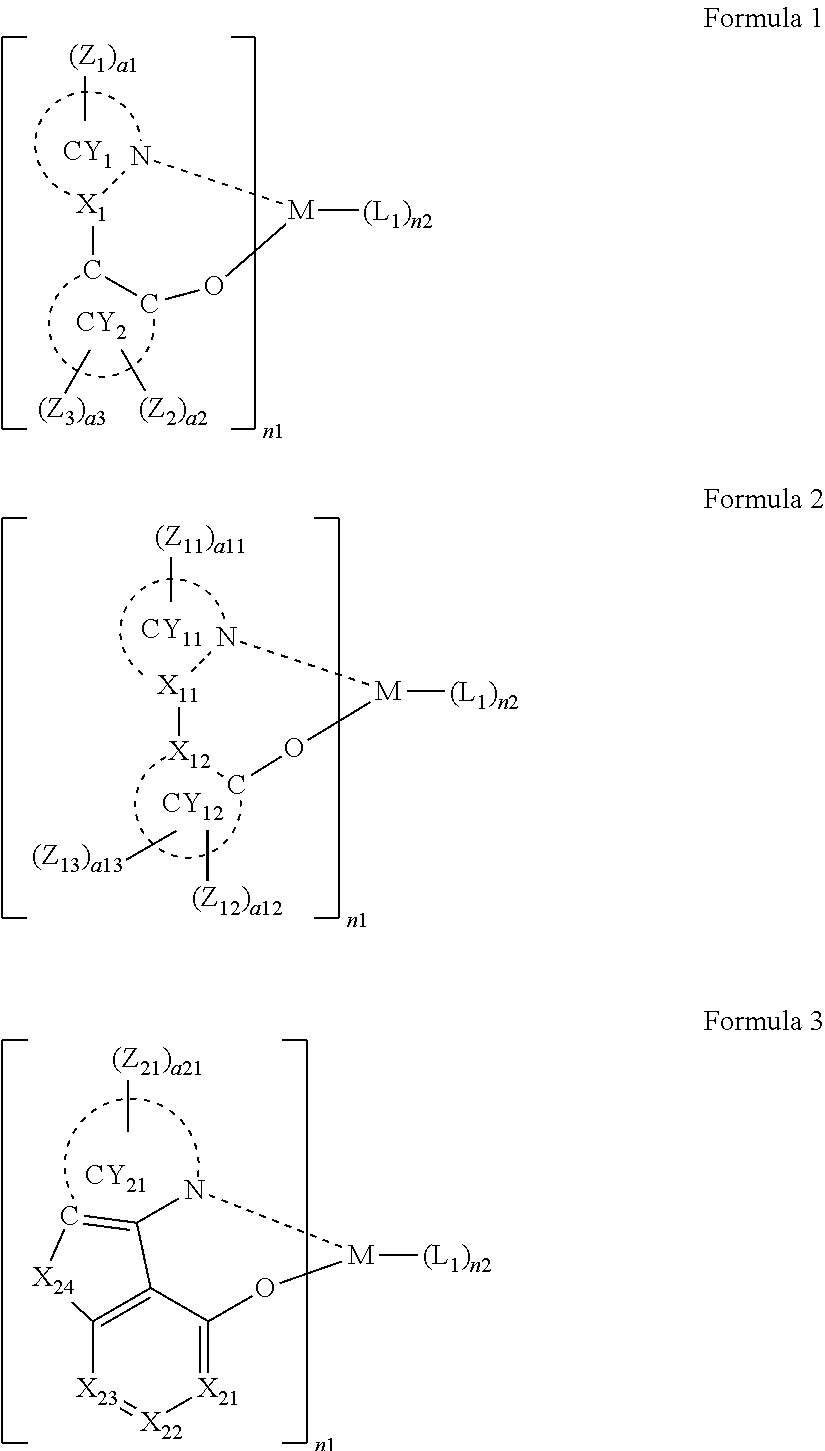
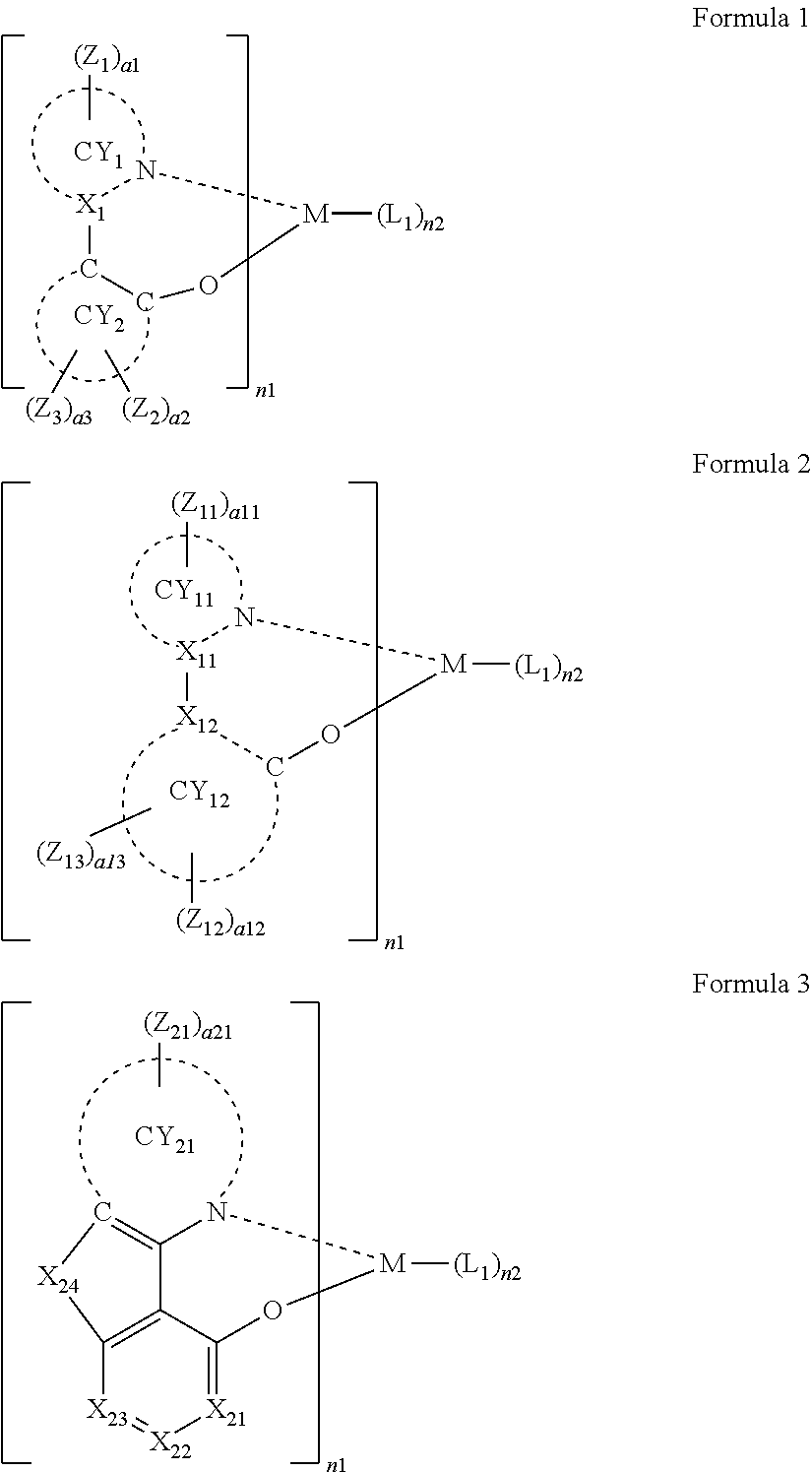



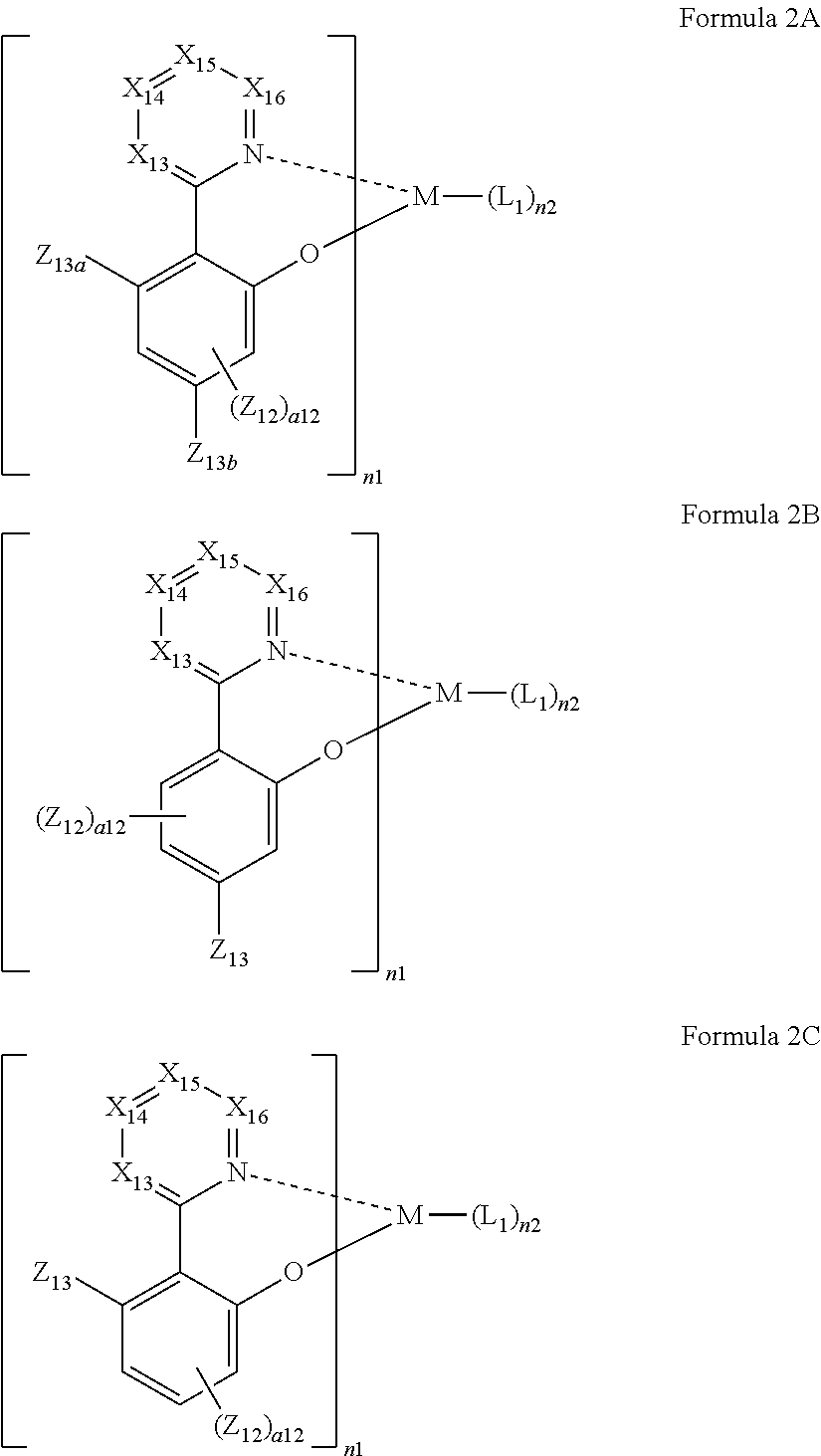
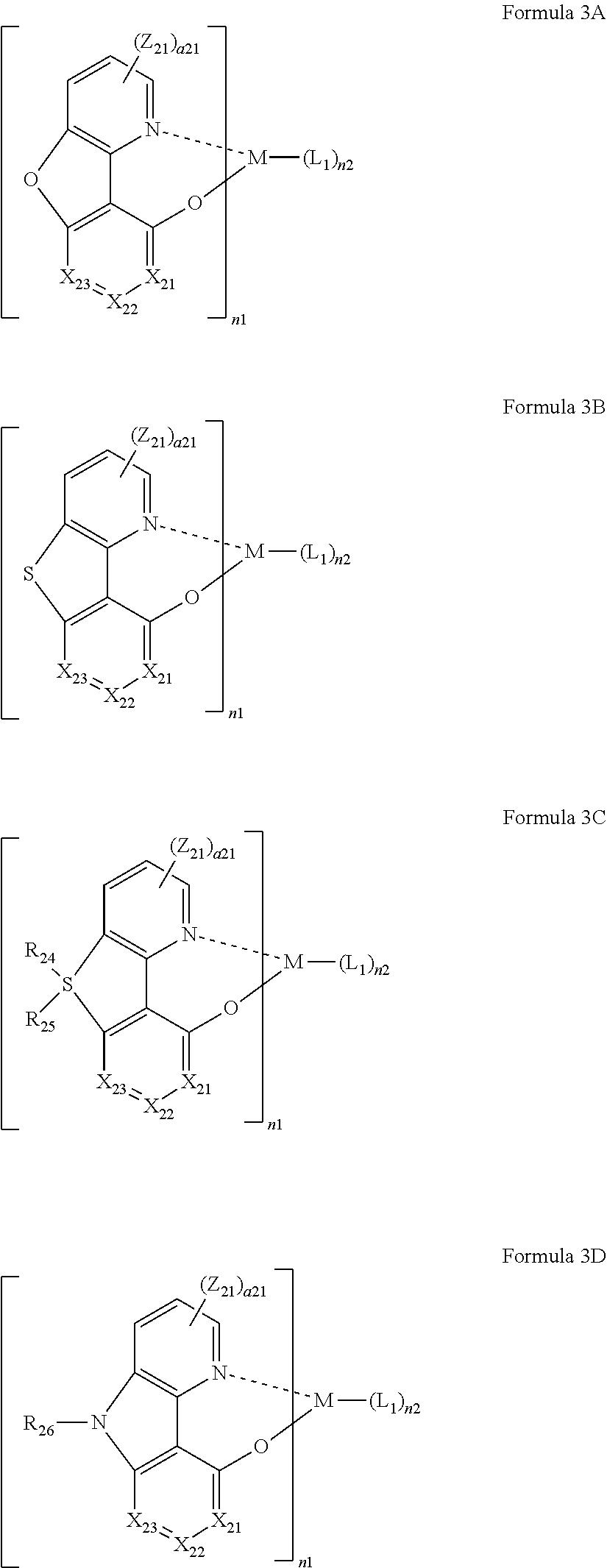




View All Diagrams
| United States Patent | 10,745,422 |
| Hwang , et al. | August 18, 2020 |
Organometallic compound and organic light-emitting device including the same
Abstract
An organometallic compound represented by Formulae 1, 2, or 3 below: ##STR00001## wherein in Formulae 1, 2, and 3, groups and variables are the same as in the specification.
| Inventors: | Hwang; Kyuyoung (Ansan-si, KR), Kwon; Ohyun (Yongin-si, KR), Choi; Hyeonho (Seoul, KR), Kim; Changwoo (Suwon-si, KR), Lee; Seungjae (Suwon-si, KR), Choi; Byoungki (Hwaseong-si, KR) | ||||||||||
|---|---|---|---|---|---|---|---|---|---|---|---|
| Applicant: |
|
||||||||||
| Assignee: | SAMSUNG ELECTRONICS CO., LTD.
(Gyeonggi-Do, KR) SAMSUNG SDI CO., LTD. (Gyeonggi-Do, KR) |
||||||||||
| Family ID: | 54355864 | ||||||||||
| Appl. No.: | 14/670,534 | ||||||||||
| Filed: | March 27, 2015 |
Prior Publication Data
| Document Identifier | Publication Date | |
|---|---|---|
| US 20150318497 A1 | Nov 5, 2015 | |
Foreign Application Priority Data
| May 1, 2014 [KR] | 10-2014-0053101 | |||
| Current U.S. Class: | 1/1 |
| Current CPC Class: | C09K 11/06 (20130101); C07F 5/069 (20130101); C09K 11/025 (20130101); H01L 51/0081 (20130101); H01L 51/5088 (20130101); H01L 51/5092 (20130101); C09K 2211/1007 (20130101); C09K 2211/1048 (20130101); C09K 2211/1059 (20130101); H01L 51/5016 (20130101); C09K 2211/1029 (20130101); C09K 2211/1044 (20130101); C09K 2211/1033 (20130101); C09K 2211/186 (20130101); H01L 51/5056 (20130101); C09K 2211/1037 (20130101); C09K 2211/1051 (20130101); C09K 2211/104 (20130101); C09K 2211/1055 (20130101); H01L 51/5096 (20130101); H01L 51/5072 (20130101) |
| Current International Class: | C07F 5/06 (20060101); C09K 11/02 (20060101); H01L 51/00 (20060101); C09K 11/06 (20060101); H01L 51/50 (20060101) |
References Cited [Referenced By]
U.S. Patent Documents
| 6383666 | May 2002 | Kim |
| 6420057 | July 2002 | Ueda |
| 7198859 | April 2007 | Kwong et al. |
| 7709105 | May 2010 | Kondakov |
| 9466804 | October 2016 | Kishino |
| 2004/0124769 | July 2004 | Ise |
| 2005/0019605 | January 2005 | Kwong |
| 2006/0269780 | November 2006 | Fukumatsu |
| 2010/0227978 | September 2010 | Stoessel et al. |
| 1067165 | Oct 2001 | EP | |||
| 09020885 | Jan 1997 | JP | |||
| 09176629 | Jul 1997 | JP | |||
| 10308277 | Nov 1998 | JP | |||
| 2000208261 | Jul 2000 | JP | |||
| 2002305083 | Oct 2002 | JP | |||
| 2002305083 | Oct 2002 | JP | |||
| 3465420 | Aug 2003 | JP | |||
| 3475620 | Sep 2003 | JP | |||
| WO 2006059802 | Jun 2006 | JP | |||
| 1019990086810 | Dec 1999 | KR | |||
| 1020080085137 | Sep 2008 | KR | |||
| 9963023 | Dec 1999 | WO | |||
| WO-9963023 | Dec 1999 | WO | |||
Other References
|
JP 2002305083 A, Oct. 2002, Machine translation (Year: 2002). cited by examiner . English Translation of Office action issued by the Korean Patent Office dated Apr. 27, 2020 in the examination of the Korean Patent Application No. 10-2014-0053101, which corresponds to the U.S. Application above. cited by applicant . Office action issued by the Korean Patent Office dated Apr. 27, 2020 in the examination of the Korean Patent Application No. 10-2014-0053101, which corresponds to the U.S. Application above. cited by applicant. |
Primary Examiner: Sastri; Satya B
Attorney, Agent or Firm: Cantor Colburn LLP
Claims
What is claimed is:
1. An organometallic compound represented by Formulae 1, 2A, 2B, 2C, or 3: ##STR00076## wherein in Formulae 1, 2A, 2B, 2C, and 3, M is Al, Ga, Be, Mg, or Zn, provided that M in Formulae 2A, 2B and 2C is Al or Ga; CY.sub.1 is selected from a pyridine, a pyrazine, a pyrimidine, a pyridazine, a triazine, a quinoline, an isoquinoline, a benzoquinoline, a quinoxaline, a quinazoline, a triazole, an oxazole, a benzooxazole, a benzo[4,5]thieno[2,3-c]pyridine, a benzofuro[2,3-c]pyridine, and a benzoisoquinoline; CY.sub.2 and CY.sub.21 are each independently a nitrogen-containing heterocyclic group; provided that when CY.sub.1 is selected from a benzooxazole and a pyridine, CY.sub.2 is selected from a pyridine, a quinoline, and an isoquinoline; X.sub.1 is N or C, X.sub.13 is N or CR.sub.13, X.sub.14 is N or CR.sub.14, X.sub.15 is N or CR.sub.15, X.sub.16 is N or CR.sub.16, X.sub.21 is N or CR.sub.21, X.sub.22 is N or CR.sub.22, X.sub.23 is N or CR.sub.23, and X.sub.24 is S, O, Si(R.sub.24)(R.sub.25), or N(R.sub.26); Z.sub.1, Z.sub.2, Z.sub.12, Z.sub.21, R.sub.13 to R.sub.16, and R.sub.21 to R.sub.26 are each independently a hydrogen, a deuterium, --F, --Cl, --Br, --I, a hydroxyl group, a cyano group, an amino group, an amidino group, a hydrazine group, a hydrazone group, a carboxylic acid or a salt thereof, a sulfonic acid or a salt thereof, a phosphoric acid or a salt thereof, a substituted or unsubstituted C.sub.1-C.sub.60 alkyl group, a substituted or unsubstituted C.sub.2-C.sub.60 alkenyl group, a substituted or unsubstituted C.sub.2-C.sub.60 alkynyl group, a substituted or unsubstituted C.sub.1-C.sub.60 alkoxy group, a substituted or unsubstituted C.sub.3-C.sub.10 cycloalkyl group, a substituted or unsubstituted C.sub.2-C.sub.10 heterocycloalkyl group, a substituted or unsubstituted C.sub.3-C.sub.10 cycloalkenyl group, a substituted or unsubstituted C.sub.2-C.sub.10 heterocycloalkenyl group, a substituted or unsubstituted C.sub.6-C.sub.60 aryl group, a substituted or unsubstituted C.sub.6-C.sub.60 aryloxy group, a substituted or unsubstituted C.sub.6-C.sub.60 arylthio group, a substituted or unsubstituted C.sub.2-C.sub.60 heteroaryl group, a substituted or unsubstituted monovalent non-aromatic condensed polycyclic group, a substituted or unsubstituted monovalent non-aromatic condensed heteropolycyclic group, --N(Q.sub.1)(Q.sub.2), --Si(Q.sub.3)(Q.sub.4)(Q.sub.5), or --B(Q.sub.6)(Q.sub.7), Z.sub.3 is electron withdrawing group; Z.sub.13, Z.sub.13a, and Z.sub.13b are each independently selected from --F, a cyano group, a nitro group, a pyridinyl group, a pyrimidinyl group, --CF.sub.3, and --CF.sub.2CF.sub.3; a1, a2, and a21 are each independently an integer selected from 0 to 5; in Formula 2A, a12 is an integer selected from 0 to 2; in Formulae 2B and 2C, a12 is an integer selected from 0 to 3; a3 is an integer selected from 1 to 5; n1 is an integer selected from 1 to 3, provided that n1 in Formulae 2A, 2B and 2C is 3; L.sub.1 is selected from a monovalent organic ligand, a divalent organic ligand, and a trivalent organic ligand, provided that L.sub.1 in Formulae 2A, 2B and 2C is selected from a halogen ligand, a diketone ligand, a carboxylic acid ligand, a carbon monooxide ligand, an isonitrile ligand, a cyano ligand, and a phosphorous ligand; n2 is an integer selected from 0 to 3; provided that CY.sub.2 in Formula 1 is not a triazine, a pyridazine, or a pyrimidine; substituents of two adjacent ligands in Formulae 1 and 2A to 2C are not linked to each other; Z.sub.13 in Formula 2B is not a nitro group; in Formula 3, when X.sub.24 is N(R.sub.26), at least one selected from X.sub.21 to X.sub.23 is N; at least one substituent of the substituted C.sub.1-C.sub.60 alkyl group, the substituted C.sub.2-C.sub.60 alkenyl group, the substituted C.sub.2-C.sub.60 alkynyl group, the substituted C.sub.1-C.sub.60 alkoxy group, the substituted C.sub.3-C.sub.10 cycloalkyl group, the substituted C.sub.2-C.sub.10 heterocycloalkyl group, the substituted C.sub.3-C.sub.10 cycloalkenyl group, the substituted C.sub.2-C.sub.10 heterocycloalkenyl group, the substituted C.sub.6-C.sub.60 aryl group, the substituted C.sub.6-C.sub.60 aryloxy group, the substituted C.sub.6-C.sub.60 arylthio group, the substituted C.sub.2-C.sub.60 heteroaryl group, the substituted a monovalent non-aromatic condensed polycyclic group, and the substituted monovalent non-aromatic condensed heteropolycyclic group is selected from a deuterium, --F, --Cl, --Br, --I, a hydroxyl group, a cyano group, a nitro group, an amino group, an amidino group, a hydrazine group, a hydrazone group, a carboxylic acid group or a salt thereof, a sulfonic acid group or a salt thereof, a phosphoric acid group or a salt thereof, a C.sub.1-C.sub.60 alkyl group, a C.sub.2-C.sub.60 alkenyl group, a C.sub.2-C.sub.60 alkynyl group, and a C.sub.1-C.sub.60 alkoxy group; a C.sub.1-C.sub.60 alkyl group, a C.sub.2-C.sub.60 alkenyl group, a C.sub.2-C.sub.60 alkynyl group, and a C.sub.1-C.sub.60 alkoxy group, each substituted with at least one selected from a deuterium, --F, --Cl, --Br, --I, a hydroxyl group, a cyano group, a nitro group, an amino group, an amidino group, a hydrazine group, a hydrazone group, a carboxylic acid or a salt thereof, a sulfonic acid or a salt thereof, a phosphoric acid or a salt thereof, a C.sub.3-C.sub.10 cycloalkyl group, a C.sub.2-C.sub.10 heterocycloalkyl group, a C.sub.3-C.sub.10 cycloalkenyl group, a C.sub.2-C.sub.10 heterocycloalkenyl group, a C.sub.6-C.sub.60 aryl group, a C.sub.6-C.sub.60 aryloxy group, a C.sub.6-C.sub.60 arylthio group, a C.sub.2-C.sub.60 heteroaryl group, a monovalent non-aromatic condensed polycyclic group, a monovalent non-aromatic condensed heteropolycyclic group, --N(Q.sub.11)(Q.sub.12), --Si(Q.sub.13)(Q.sub.14)(Q.sub.15), and --B(Q.sub.16)(Q.sub.17); a C.sub.3-C.sub.10 cycloalkyl group, a C.sub.2-C.sub.10 heterocycloalkyl group, a C.sub.3-C.sub.10 cycloalkenyl group, a C.sub.2-C.sub.10 heterocycloalkenyl group, a C.sub.6-C.sub.60 aryl group, a C.sub.6-C.sub.60 aryloxy group, a C.sub.6-C.sub.60 arylthio group, a C.sub.2-C.sub.60 heteroaryl group, a monovalent non-aromatic condensed polycyclic group, and a monovalent non-aromatic condensed heteropolycyclic group; a C.sub.3-C.sub.10 cycloalkyl group, a C.sub.2-C.sub.10 heterocycloalkyl group, a C.sub.3-C.sub.10 cycloalkenyl group, a C.sub.2-C.sub.10 heterocycloalkenyl group, a C.sub.6-C.sub.60 aryl group, a C.sub.6-C.sub.60 aryloxy group, a C.sub.6-C.sub.60 arylthio group, a C.sub.2-C.sub.60 heteroaryl group, a monovalent non-aromatic condensed polycyclic group, and a monovalent non-aromatic condensed heteropolycyclic group, each substituted with at least one selected from a deuterium, --F, --Cl, --Br, --I, a hydroxyl group, a cyano group, a nitro group, an amino group, an amidino group, a hydrazine group, a hydrazone group, a carboxylic acid or a salt thereof, a sulfonic acid or a salt thereof, a phosphoric acid or a salt thereof, a C.sub.1-C.sub.60 alkyl group, a C.sub.2-C.sub.60 alkenyl group, a C.sub.2-C.sub.60 alkynyl group, a C.sub.1-C.sub.60 alkoxy group, a C.sub.3-C.sub.10 cycloalkyl group, a C.sub.2-C.sub.10 heterocycloalkyl group, a C.sub.3-C.sub.10 cycloalkenyl group, a C.sub.2-C.sub.10 heterocycloalkenyl group, a C.sub.6-C.sub.60 aryl group, a C.sub.6-C.sub.60 aryloxy group, a C.sub.6-C.sub.60 arylthio group, a C.sub.2-C.sub.60 heteroaryl group, a monovalent non-aromatic condensed polycyclic group, a monovalent non-aromatic condensed heteropolycyclic group, --N(Q.sub.21)(Q.sub.22), --Si(Q.sub.23)(Q.sub.24)(Q.sub.25), and --B(Q.sub.26)(Q.sub.27); and --N(Q.sub.31)(Q.sub.32), --Si(Q.sub.33)(Q.sub.34)(Q.sub.35), or --B(Q.sub.36)(Q.sub.37); wherein Q.sub.1 to Q.sub.7, Q.sub.11 to Q.sub.17, Q.sub.21 to Q.sub.27, and Q.sub.31 to Q.sub.37 are each independently selected from a hydrogen, a C.sub.1-C.sub.60 alkyl group, a C.sub.2-C.sub.60 alkenyl group, a C.sub.2-C.sub.60 alkynyl group, a C.sub.1-C.sub.60 alkoxy group, a C.sub.3-C.sub.10 cycloalkyl group, a C.sub.2-C.sub.10 heterocycloalkyl group, a C.sub.3-C.sub.10 cycloalkenyl group, a C.sub.2-C.sub.10 heterocycloalkenyl group, a C.sub.6-C.sub.60 aryl group, a C.sub.2-C.sub.60 heteroaryl group, a monovalent non-aromatic condensed polycyclic group, and a monovalent non-aromatic condensed heteropolycyclic group.
2. The organometallic compound of claim 1, wherein CY.sub.2 is a nitrogen-containing heterocyclic group comprising one nitrogen as a ring forming element.
3. The organometallic compound of claim 1, wherein CY.sub.2 is selected from a pyridine, a quinoline, and an isoquinoline.
4. The organometallic compound of claim 1, wherein Z.sub.1, Z.sub.2, Z.sub.12, Z.sub.21, and R.sub.21 to R.sub.26 are each independently selected from a hydrogen, a deuterium, --F, --Cl, --Br, --I, a hydroxyl group, a cyano group, a nitro group, an amino group, an amidino group, a hydrazine group, a hydrazone group, a carboxylic acid or a salt thereof, a sulfonic acid or a salt thereof, a phosphoric acid or a salt thereof, a C.sub.1-C.sub.20 alkyl group, and a C.sub.1-C.sub.20 alkoxy group; a C.sub.1-C.sub.20 alkyl group and a C.sub.1-C.sub.20 alkoxy group, each substituted with at least one selected from a deuterium, --F, --Cl, --Br, --I, a hydroxyl group, a cyano group, a nitro group, an amino group, an amidino group, a hydrazine group, a hydrazone group, a carboxylic acid or a salt thereof, a sulfonic acid or a salt thereof, and a phosphoric acid or a salt thereof; a phenyl group, a pentalenyl group, an indenyl group, a naphthyl group, an azulenyl group, a heptalenyl group, an indacenyl group, an acenaphthyl group, a fluorenyl group, a spiro-fluorenyl group, a benzofluorenyl group, a dibenzofluorenyl group, a phenalenyl group, a phenanthrenyl group, an anthracenyl group, a fluoranthenyl group, a triphenylenyl group, a pyrenyl group, a chrysenyl group, a naphthacenyl group, a picenyl group, a perylenyl group, a pentaphenyl group, a hexacenyl group, a pentacenyl group, a rubicenyl group, a coronenyl group, an ovalenyl group, a pyrrolyl group, a thiophenyl group, a furanyl group, an imidazolyl group, a pyrazolyl group, a thiazolyl group, an isothiazolyl group, an oxazolyl group, an isooxazolyl group, a pyridinyl group, a pyrazinyl group, a pyrimidinyl group, a pyridazinyl group, an isoindolyl group, an indolyl group, an indazolyl group, a furinyl group, a quinolinyl group, an isoquinolinyl group, a benzoquinolinyl group, a phthalazinyl group, a naphthyridinyl group, a quinoxalinyl group, a quinazolinyl group, a cinnolinyl group, a carbazolyl group, a phenanthridinyl group, an acridinyl group, a phenanthrolinyl group, a phenazinyl group, a benzoimidazolyl group, a benzofuranyl group, a benzothiophenyl group, an isobenzothiazolyl group, a benzooxazolyl group, an isobenzooxazolyl group, a triazolyl group, a tetrazolyl group, an oxadiazolyl group, a triazinyl group, a dibenzofuranyl group, a dibenzothiophenyl group, a benzocarbazolyl group, a dibenzocarbazolyl group, a thiadiazolyl group, an imidazopyridinyl group, and an imidazopyrimidinyl group; a phenyl group, a pentalenyl group, an indenyl group, a naphthyl group, an azulenyl group, a heptalenyl group, an indacenyl group, an acenaphthyl group, a fluorenyl group, a spiro-fluorenyl group, a benzofluorenyl group, a dibenzofluorenyl group, a phenalenyl group, a phenanthrenyl group, an anthracenyl group, a fluoranthenyl group, a triphenylenyl group, a pyrenyl group, a chrysenyl group, a naphthacenyl group, a picenyl group, a perylenyl group, a pentaphenyl group, a hexacenyl group, a pentacenyl group, a rubicenyl group, a coronenyl group, an ovalenyl group, a pyrrolyl group, a thiophenyl group, a furanyl group, an imidazolyl group, a pyrazolyl group, a thiazolyl group, an isothiazolyl group, an oxazolyl group, an isooxazolyl group, a pyridinyl group, a pyrazinyl group, a pyrimidinyl group, a pyridazinyl group, an isoindolyl group, an indolyl group, an indazolyl group, a furinyl group, a quinolinyl group, an isoquinolinyl group, a benzoquinolinyl group, a phthalazinyl group, a naphthyridinyl group, a quinoxalinyl group, a quinazolinyl group, a cinnolinyl group, a carbazolyl group, a phenanthridinyl, an acridinyl, a phenanthrolinyl, a phenazinyl, a benzoimidazolyl group, a benzofuranyl group, a benzothiophenyl group, an isobenzothiazolyl group, a benzooxazolyl group, an isobenzooxazolyl group, a triazolyl group, a tetrazolyl group, an oxadiazolyl group, a triazinyl group, a dibenzofuranyl group, a dibenzothiophenyl group, a benzocarbazolyl group, a dibenzocarbazolyl group, an imidazopyridinyl group, and an imidazopyrimidinyl group, each substituted with at least one selected from a deuterium, --F, --Cl, --Br, --I, a hydroxyl group, a cyano group, a nitro group, an amino group, an amidino group, a hydrazine group, a hydrazone group, a carboxylic acid or a salt thereof, a sulfonic acid or a salt thereof, a phosphoric acid or a salt thereof, a C.sub.1-C.sub.20 alkyl group, a C.sub.1-C.sub.20 alkoxy group, a phenyl group, a pentalenyl group, an indenyl group, a naphthyl group, an azulenyl group, a heptalenyl group, an indacenyl group, an acenaphthyl group, a fluorenyl group, a spiro-fluorenyl group, a benzofluorenyl group, a dibenzofluorenyl group, a phenalenyl group, a phenanthrenyl group, an anthracenyl group, a fluoranthenyl group, a triphenylenyl group, a pyrenyl group, a chrysenyl group, a naphthacenyl group, a picenyl group, a perylenyl group, a pentaphenyl group, a hexacenyl group, a pentacenyl group, a rubicenyl group, a coronenyl group, an ovalenyl group, a pyrrolyl group, a thiophenyl group, a furanyl group, an imidazolyl group, a pyrazolyl group, a thiazolyl group, an isothiazolyl group, an oxazolyl group, an isooxazolyl group, a pyridinyl group, a pyrazinyl group, a pyrimidinyl group, a pyridazinyl group, an isoindolyl group, an indolyl group, an indazolyl group, a furinyl group, a quinolinyl group, an isoquinolinyl group, a benzoquinolinyl group, a phthalazinyl group, a naphthyridinyl group, a quinoxalinyl group, a quinazolinyl group, a cinnolinyl group, a carbazolyl group, a phenanthridinyl, an acridinyl, a phenanthrolinyl, a phenazinyl, a benzoimidazolyl group, a benzofuranyl group, a benzothiophenyl group, an isobenzothiazolyl group, a benzooxazolyl group, an isobenzooxazolyl group, a triazolyl group, a tetrazolyl group, an oxadiazolyl group, a triazinyl group, a dibenzofuranyl group, a dibenzothiophenyl group, a benzocarbazolyl group, a dibenzocarbazolyl group, an imidazopyridinyl group, an imidazopyrimidinyl group, and a biphenyl group; and --N(Q.sub.1)(Q.sub.2) and --Si(Q.sub.3)(Q.sub.4)(Q.sub.5), wherein Q.sub.1 to Q.sub.5 are each independently selected from a hydrogen, a C.sub.1-C.sub.2o alkyl group, a C.sub.1-C.sub.20 alkoxy group, a phenyl group, a naphthyl group, an anthracenyl group, a pyrenyl group, a phenanthrenyl group, a fluorenyl group, a chrysenyl group, a carbazolyl group, a benzocarbazolyl group, a dibenzocarbazolyl group, a dibenzofuranyl group, a dibenzothiophenyl group, a pyridinyl group, a pyrimidinyl group, a triazinyl group, a quinolinyl group, an isoquinolinyl group, a quinazolinyl group, and a quinoxalinyl group.
5. The organometallic compound of claim 1, wherein Z.sub.1, Z.sub.2, Z.sub.12, Z.sub.21, and R.sub.21 to R.sub.26 are each independently selected from a hydrogen, a deuterium, --F, --Cl, --Br, --I, a hydroxyl group, a cyano group, a nitro group, an amino group, an amidino group, a hydrazine group, a hydrazone group, a carboxylic acid or a salt thereof, a sulfonic acid or a salt thereof, a phosphoric acid or a salt thereof, a C.sub.1-C.sub.20 alkyl group, and a C.sub.1-C.sub.20 alkoxy group; a C.sub.1-C.sub.20 alkyl group and a C.sub.1-C.sub.20 alkoxy group, each substituted with at least one selected from a deuterium, --F, --Cl, --Br, --I, a hydroxyl group, a cyano group, a nitro group, an amino group, an amidino group, a hydrazine group, a hydrazone group, a carboxylic acid or a salt thereof, a sulfonic acid or a salt thereof, and a phosphoric acid or a salt thereof; a phenyl group, a naphthyl group, a fluorenyl group, a spiro-fluorenyl group, a phenalenyl group, a phenanthrenyl group, an anthracenyl group, a pyrenyl group, a chrysenyl group, a pyridinyl group, a pyrimidinyl group, a quinolinyl group, an isoquinolinyl group, a quinoxalinyl group, a quinazolinyl group, and a carbazolyl group; and a phenyl group, a naphthyl group, a fluorenyl group, a spiro-fluorenyl group, a phenalenyl group, a phenanthrenyl group, an anthracenyl group, a pyrenyl group, a chrysenyl group, a pyridinyl group, a pyrimidinyl group, a quinolinyl group, an isoquinolinyl group, a quinoxalinyl group, a quinazolinyl group, and a carbazolyl group, each substituted with at least one selected from a deuterium, --F, --Cl, --Br, --I, a hydroxyl group, a cyano group, a nitro group, an amino group, an amidino group, a hydrazine group, a hydrazone group, a carboxylic acid or a salt thereof, a sulfonic acid or a salt thereof, a phosphoric acid or a salt thereof, a C.sub.1-C.sub.20 alkyl group, a C.sub.1-C.sub.20 alkoxy group, a phenyl group, a naphthyl group, a fluorenyl group, a spiro-fluorenyl group, a phenalenyl group, a phenanthrenyl group, an anthracenyl group, a pyrenyl group, a chrysenyl group, a pyridinyl group, a pyrimidinyl group, a quinolinyl group, an isoquinolinyl group, a quinoxalinyl group, a quinazolinyl group, and a carbazolyl group.
6. The organometallic compound of claim 1, wherein Z.sub.3 is selected from --F, a cyano group, a nitro group, a pyridinyl group, and a pyrimidinyl group; and a C.sub.1-C.sub.20 alkyl group, a C.sub.1-C.sub.20 alkoxy group, a phenyl group, a naphthyl group, a pyridinyl group, and a pyrimidinyl group, each substituted with at least one selected from --F, a cyano group, a nitro group, a pyridinyl group, and a pyrimidinyl group.
7. The organometallic compound of claim 1, wherein at least one group Z.sub.1 is an electron withdrawing group.
8. An organometallic compound represented by one of Formulae 1A to 1K: ##STR00077## ##STR00078## ##STR00079## wherein in Formulae 1A to 1K, M is Al, Ga, Be, Mg, or Zn; n1 is an integer selected from 1 to 3; L.sub.1 is selected from a monovalent organic ligand, a divalent organic ligand, and a trivalent organic ligand; n2 is an integer selected from 0 to 3; Z.sub.1 and Z.sub.2 are each independently a hydrogen, a deuterium, --F, --Br, --I, a hydroxyl group, a cyano group, a nitro group, an amino group, an amidino group, a hydrazine group, a hydrazone group, a carboxylic acid or a salt thereof, a sulfonic acid or a salt thereof, a phosphoric acid or a salt thereof, a substituted or unsubstituted C.sub.1-C.sub.60 alkyl group, a substituted or unsubstituted C.sub.2-C.sub.60 alkenyl group, a substituted or unsubstituted C.sub.2-C.sub.60 alkynyl group, a substituted or unsubstituted C.sub.1-C.sub.60 alkoxy group, a substituted or unsubstituted C.sub.3-C.sub.10 cycloalkyl group, a substituted or unsubstituted C.sub.2-C.sub.10 heterocycloalkyl group, a substituted or unsubstituted C.sub.3-C.sub.10 cycloalkenyl group, a substituted or unsubstituted C.sub.2-C.sub.10 heterocycloalkenyl group, a substituted or unsubstituted C.sub.6-C.sub.60 aryl group, a substituted or unsubstituted C.sub.6-C.sub.60 aryloxy group, a substituted or unsubstituted C.sub.6-C.sub.60 arylthio group, a substituted or unsubstituted C.sub.2-C.sub.60 heteroaryl group, a substituted or unsubstituted monovalent non-aromatic condensed polycyclic group, a substituted or unsubstituted monovalent non-aromatic condensed heteropolycyclic group, --N(Q.sub.1)(Q.sub.2), --Si(Q.sub.3)(Q.sub.4)(Q.sub.5), or --B(Q.sub.6)(Q.sub.7), Z.sub.3 is an electron withdrawing group; A1 and a2 are each independently an integer selected from 0 to 5; a3 is an integer selected from 1 to 5; and CY.sub.2 is a pyridine, a quinoline, or an isoquinoline.
9. The organometallic compound of claim 8, wherein Z.sub.1 and Z.sub.2 are each independently selected from a hydrogen, --F, a cyano group, a nitro group, a methyl group, an ethyl group, a propyl group, an n-butyl group, an isobutyl group, a sec-butyl group, a tert-butyl group, an n-pentyl group, an isopentyl group, a sec-pentyl group, a tert-pentyl group, an n-hexyl group, an isohexyl group, a sec-hexyl group, a tert-hexyl group, an n-heptyl group, an isoheptyl group, a sec-heptyl group, a tert-heptyl group, an n-octyl group, an isooctyl group, a sec-octyl group, a tert-octyl group, an n-nonyl group, an isononyl group, a sec-nonyl group, a tert-nonyl group, an n-decanyl group, an isodecanyl group, a sec-decanyl group, a tert-decanyl group, a methoxy group, an ethoxy group, a propoxy group, a butoxy group, a pentoxy group, a phenyl group, a naphthyl group, a pyridinyl group, and a pyrimidinyl group; and a methyl group, an ethyl group, a propyl group, an n-butyl group, an isobutyl group, a sec-butyl group, a tert-butyl group, an n-pentyl group, an isopentyl group, a sec-pentyl group, a tert-pentyl group, an n-hexyl group, an isohexyl group, a sec-hexyl group, a tert-hexyl group, an n-heptyl group, an isoheptyl group, a sec-heptyl group, a tert-heptyl group, an n-octyl group, an isooctyl group, a sec-octyl group, a tert-octyl group, an n-nonyl group, an isononyl group, a sec-nonyl group, a tert-nonyl group, an n-decanyl group, an isodecanyl group, a sec-decanyl group, a tert-decanyl group, a methoxy group, an ethoxy group, a propoxy, a butoxy group, a pentoxy group, a phenyl group, a naphthyl group, a pyridinyl group, and a pyrimidinyl group, each substituted with at least one selected from --F, a cyano group, a nitro group, a C.sub.1-C.sub.20 alkoxy group, a C.sub.1-C.sub.20 alkoxy group, a phenyl group, a naphthyl group, a pyridinyl group, and a pyrimidinyl group.
10. The organometallic compound of claim 1, wherein Z.sub.12 and R.sub.13 to R.sub.16 are each independently selected from a hydrogen, --F, a cyano group, a nitro group, a methyl group, an ethyl group, a propyl group, an n-butyl group, an isobutyl group, a sec-butyl group, a tert-butyl group, an n-pentyl group, an isopentyl group, a sec-pentyl group, a tert-pentyl group, an n-hexyl group, an isohexyl group, a sec-hexyl group, a tert-hexyl group, an n-heptyl group, an isoheptyl group, a sec-heptyl group, a tert-heptyl group, an n-octyl group, an isooctyl group, a sec-octyl group, a tert-octyl group, an n-nonyl group, an isononyl group, a sec-nonyl group, a tert-nonyl group, an n-decanyl group, an isodecanyl group, a sec-decanyl group, a tert-decanyl group, a methoxy group, an ethoxy group, a propoxy group, a butoxy group, a pentoxy group, a phenyl group, a naphthyl group, a pyridinyl group, and a pyrimidinyl group; and a methyl group, an ethyl group, a propyl group, an n-butyl group, an isobutyl group, a sec-butyl group, a tert-butyl group, an n-pentyl group, an isopentyl group, a sec-pentyl group, a tert-pentyl group, an n-hexyl group, an isohexyl group, a sec-hexyl group, a tert-hexyl group, an n-heptyl group, an isoheptyl group, a sec-heptyl group, a tert-heptyl group, an n-octyl group, an isooctyl group, a sec-octyl group, a tert-octyl group, an n-nonyl group, an isononyl group, a sec-nonyl group, a tert-nonyl group, an n-decanyl group, an isodecanyl group, a sec-decanyl group, a tert-decanyl group, a methoxy group, an ethoxy group, a propoxy, a butoxy group, a pentoxy group, a phenyl group, a naphthyl group, a pyridinyl group, and a pyrimidinyl group, each substituted with at least one selected from --F, a cyano group, a nitro group, a C.sub.1-C.sub.20 alkoxy group, a C.sub.1-C.sub.20 alkoxy group, a phenyl group, a naphthyl group, a pyridinyl group, and a pyrimidinyl group.
11. An organometallic compound, represented by one of Formulae 3A to 3D: ##STR00080## wherein in Formulae 3A to 3D, M is Al, Ga, Be, Mg, or Zn; X.sub.21 is N or CR.sub.21, X.sub.22 is N or CR.sub.22, X.sub.23 is N or CR.sub.23, n1 is an integer selected from 1 to 3; L.sub.1 is selected from a monovalent organic ligand, a divalent organic ligand, and a trivalent organic ligand; n2 is an integer selected from 0 to 3; and Z.sub.21, and R.sub.24 to R.sub.26 are each independently a hydrogen, a deuterium, --F, --Cl, --Br, --I, a hydroxyl group, a cyano group, an amino group, an amidino group, a hydrazine group, a hydrazone group, a carboxylic acid or a salt thereof, a sulfonic acid or a salt thereof, a phosphoric acid or a salt thereof, a substituted or unsubstituted C.sub.1-C.sub.60 alkyl group, a substituted or unsubstituted C.sub.2-C.sub.60 alkenyl group, a substituted or unsubstituted C.sub.2-C.sub.60 alkynyl group, a substituted or unsubstituted C.sub.1-C.sub.60 alkoxy group, a substituted or unsubstituted C.sub.3-C.sub.10 cycloalkyl group, a substituted or unsubstituted C.sub.2-C.sub.10 heterocycloalkyl group, a substituted or unsubstituted C.sub.3-C.sub.10 cycloalkenyl group, a substituted or unsubstituted C.sub.2-C.sub.10 heterocycloalkenyl group, a substituted or unsubstituted C.sub.6-C.sub.60 aryl group, a substituted or unsubstituted C.sub.6-C.sub.60 aryloxy group, a substituted or unsubstituted C.sub.6-C.sub.60 arylthio group, a substituted or unsubstituted C.sub.2-C.sub.60 heteroaryl group, a substituted or unsubstituted monovalent non-aromatic condensed polycyclic group, a substituted or unsubstituted monovalent non-aromatic condensed heteropolycyclic group, --N(Q.sub.1)(Q.sub.2), --Si(Q.sub.3)(Q.sub.4)(Q.sub.5), or --B(Q.sub.6)(Q.sub.7); a21 is an integer selected from 0 to 5; at least one of X.sub.21 to X.sub.23 in Formula 3D is N.
12. The organic light-emitting device of claim 11, wherein Z.sub.21 and R.sub.21 to R.sub.26 are each independently selected from a hydrogen, --F, a cyano group, a nitro group, a methyl group, an ethyl group, a propyl group, an n-butyl group, an isobutyl group, a sec-butyl group, a tert-butyl group, an n-pentyl group, an isopentyl group, a sec-pentyl group, a tert-pentyl group, an n-hexyl group, an isohexyl group, a sec-hexyl group, a tert-hexyl group, an n-heptyl group, an isoheptyl group, a sec-heptyl group, a tert-heptyl group, an n-octyl group, an isooctyl group, a sec-octyl group, a tert-octyl group, an n-nonyl group, an isononyl group, a sec-nonyl group, a tert-nonyl group, an n-decanyl group, an isodecanyl group, a sec-decanyl group, a tert-decanyl group, a methoxy group, an ethoxy group, a propoxy group, a butoxy group, a pentoxy group, a phenyl group, a naphthyl group, a pyridinyl group, and a pyrimidinyl group; and a methyl group, an ethyl group, a propyl group, an n-butyl group, an isobutyl group, a sec-butyl group, a tert-butyl group, an n-pentyl group, an isopentyl group, a sec-pentyl group, a tert-pentyl group, an n-hexyl group, an isohexyl group, a sec-hexyl group, a tert-hexyl group, an n-heptyl group, an isoheptyl group, a sec-heptyl group, a tert-heptyl group, an n-octyl group, an isooctyl group, a sec-octyl group, a tert-octyl group, an n-nonyl group, an isononyl group, a sec-nonyl group, a tert-nonyl group, an n-decanyl group, an isodecanyl group, a sec-decanyl group, a tert-decanyl group, a methoxy group, an ethoxy group, a propoxy, a butoxy group, a pentoxy group, a phenyl group, a naphthyl group, a pyridinyl group, and a pyrimidinyl group, each substituted with at least one selected from --F, a cyano group, a nitro group, a C.sub.1-C.sub.20 alkoxy group, a C.sub.1-C.sub.20 alkoxy group, a phenyl group, a naphthyl group, a pyridinyl group, and a pyrimidinyl group.
13. An organic light-emitting device comprising: a first electrode; a second electrode; and an organic layer disposed between the first electrode and the second electrode, wherein the organic layer comprises an emission layer, and at least one of the organometallic compound of claim 1.
14. The organic light-emitting device of claim 13, wherein the first electrode is an anode, the second electrode is a cathode, and the organic layer comprises i) a hole transport region disposed between the first electrode and the emission layer and comprises at least one of a hole injection layer, a hole transport layer, and an electron blocking layer, and ii) an electron transport region disposed between the emission layer and the second electrode and comprising at least one selected from a hole blocking layer, an electron transport layer, and an electron injection layer.
15. The organic light-emitting device of claim 13, wherein the emission layer comprises the organometallic compound.
Description
CROSS-REFERENCE TO RELATED APPLICATIONS
This application claims priority to Korean Patent Application No. 10-2014-0053101, filed on May 1, 2014, in the Korean Intellectual Property Office, and all the benefits accruing thereof under 35 U.S.C. .sctn. 119, the disclosure of which is incorporated herein in its entirety by reference.
BACKGROUND
1. Field
One or more embodiments relate to an organometallic compound and an organic light-emitting device including the same.
2. Description of the Related Art
Organic light emitting devices are self-emission devices that have wide viewing angles, high contrast ratios, and short response times. In addition, OLEDs have excellent brightness, driving voltage, and response speed characteristics, and produce full-color images.
A typical organic light-emitting device includes an anode, a cathode, and an organic layer that is disposed between the anode and the cathode and includes an emission layer. A hole transport region may be disposed between the anode and the emission layer, and an electron transport region may be disposed between the emission layer and the cathode. Holes provided from the anode may move toward the emission layer through the hole transport region, and electrons provided from the cathode may move toward the emission layer through the electron transport region. Carriers, such as holes and electrons, are recombined in the emission layer to produce excitons. These excitons change from an excited state to a ground state, thereby generating light.
Different types of organic light emitting devices are known. However, there still remains a need in OLEDs having low driving voltage, high efficiency, high brightness, and long lifespan.
SUMMARY
Provided are a novel organometallic compound and an organic light-emitting device including the same.
Additional aspects will be set forth in part in the description which follows and, in part, will be apparent from the description, or may be learned by practice of the presented embodiments.
According to an aspect, an organometallic compound is represented by Formula 1, 2, or 3 below:
##STR00002##
wherein in Formulae 1, 2, and 3,
M may be Al, Ga, Be, Mg, or Zn;
CY.sub.1, CY.sub.2, CY.sub.11, and CY.sub.21 may be each independently a nitrogen-containing heterocyclic group;
CY.sub.12 is selected from an aromatic cyclic group and a non-aromatic cyclic group;
X.sub.1 may be N or C,
X.sub.11 may be N or C,
X.sub.12 may be N or C,
X.sub.21 may be N or CR.sub.21,
X.sub.22 may be N or CR.sub.22,
X.sub.23 may be N or CR.sub.23, and
X.sub.24 may be S, O, Si(R.sub.24)(R.sub.25), or N(R.sub.26);
Z.sub.1, Z.sub.2, Z.sub.11, Z.sub.12, Z.sub.21, and R.sub.21 to R.sub.26 may be each independently selected from a hydrogen, a deuterium, --F, --Cl, --Br, --I, a hydroxyl group, a cyano group, a nitro group, an amino group, an amidino group, a hydrazine group, a hydrazone group, a carboxylic acid or a salt thereof, a sulfonic acid or a salt thereof, a phosphoric acid or a salt thereof, a substituted or unsubstituted C.sub.1-C.sub.60 alkyl group, a substituted or unsubstituted C.sub.2-C.sub.60 alkenyl group, a substituted or unsubstituted C.sub.2-C.sub.60 alkynyl group, a substituted or unsubstituted C.sub.1-C.sub.60 alkoxy group, a substituted or unsubstituted C.sub.3-C.sub.10 cycloalkyl group, a substituted or unsubstituted C.sub.2-C.sub.10 heterocycloalkyl group, a substituted or unsubstituted C.sub.3-C.sub.10 cycloalkenyl group, a substituted or unsubstituted C.sub.2-C.sub.10 heterocycloalkenyl group, a substituted or unsubstituted C.sub.6-C.sub.60 aryl group, a substituted or unsubstituted C.sub.6-C.sub.60 aryloxy group, a substituted or unsubstituted C.sub.6-C.sub.60 arylthio group, a substituted or unsubstituted C.sub.2-C.sub.60 heteroaryl group, a substituted or unsubstituted monovalent non-aromatic condensed polycyclic group, a substituted or unsubstituted monovalent non-aromatic condensed heteropolycyclic group, --N(Q.sub.1)(Q.sub.2), --Si(Q.sub.3)(Q.sub.4)(Q.sub.5), and --B(Q.sub.6)(Q.sub.7);
Z.sub.3 and Z.sub.13 may each be an electron withdrawing group;
a1, a2, a3, a11, a12 and a21 may be each independently an integer selected from 0 to 5;
a13 is an integer selected from 1 to 5;
n1 is an integer selected from 1 to 3;
L.sub.1 is selected from a monovalent organic ligand, a divalent organic ligand, and a trivalent organic ligand;
n2 is an integer selected from 0 to 3;
provided that
CY.sub.2 in Formula 1 may not be a triazine, a pyridazine, and a pyrimidine;
substituents of two adjacent ligands in Formulae 1 and 2 may not be linked to each other;
in Formula 3, when X.sub.24 is N(R.sub.26), at least one selected from X.sub.21 to X.sub.23 may be N;
at least one substituent of the substituted C.sub.1-C.sub.60 alkyl group, the substituted C.sub.2-C.sub.60 alkenyl group, the substituted C.sub.2-C.sub.60 alkynyl group, the substituted C.sub.1-C.sub.60 alkoxy group, the substituted C.sub.3-C.sub.10 cycloalkyl group, the substituted C.sub.2-C.sub.10 heterocycloalkyl group, the substituted C.sub.3-C.sub.10 cycloalkenyl group, the substituted C.sub.2-C.sub.10 heterocycloalkenyl group, the substituted C.sub.6-C.sub.60 aryl group, the substituted C.sub.6-C.sub.60 aryloxy group, the substituted C.sub.6-C.sub.60 arylthio group, the substituted C.sub.2-C.sub.60 heteroaryl group, the substituted a monovalent non-aromatic condensed polycyclic group, and the substituted monovalent non-aromatic condensed heteropolycyclic group may be selected from
a deuterium, --F, --Cl, --Br, --I, a hydroxyl group, a cyano group, a nitro group, an amino group, an amidino group, a hydrazine group, a hydrazone group, a carboxylic acid group or a salt thereof, a sulfonic acid group or a salt thereof, a phosphoric acid group or a salt thereof, a C.sub.1-C.sub.60 alkyl group, a C.sub.2-C.sub.60 alkenyl group, a C.sub.2-C.sub.60 alkynyl group, and a C.sub.1-C.sub.60 alkoxy group;
a C.sub.1-C.sub.60 alkyl group, a C.sub.2-C.sub.60 alkenyl group, a C.sub.2-C.sub.60 alkynyl group, and a C.sub.1-C.sub.60 alkoxy group, each substituted with at least one selected from a deuterium, --F, --Cl, --Br, --I, a hydroxyl group, a cyano group, a nitro group, an amino group, an amidino group, a hydrazine group, a hydrazone group, a carboxylic acid or a salt thereof, a sulfonic acid or a salt thereof, a phosphoric acid or a salt thereof, a C.sub.3-C.sub.10 cycloalkyl group, a C.sub.2-C.sub.10 heterocycloalkyl group, a C.sub.3-C.sub.10 cycloalkenyl group, a C.sub.2-C.sub.10 heterocycloalkenyl group, a C.sub.6-C.sub.60 aryl group, a C.sub.6-C.sub.60 aryloxy group, a C.sub.6-C.sub.60 arylthio group, a C.sub.2-C.sub.60 heteroaryl group, a monovalent non-aromatic condensed polycyclic group, a monovalent non-aromatic condensed heteropolycyclic group, --N(Q.sub.11)(Q.sub.12), --Si(Q.sub.13)(Q.sub.14)(Q.sub.15), and --B(Q.sub.16)(Q.sub.17);
a C.sub.3-C.sub.10 cycloalkyl group, a C.sub.2-C.sub.10 heterocycloalkyl group, a C.sub.3-C.sub.10 cycloalkenyl group, a C.sub.2-C.sub.10 heterocycloalkenyl group, a C.sub.6-C.sub.60 aryl group, a C.sub.6-C.sub.60 aryloxy group, a C.sub.6-C.sub.60 arylthio group, a C.sub.2-C.sub.60 heteroaryl group, a monovalent non-aromatic condensed polycyclic group, and a monovalent non-aromatic condensed heteropolycyclic group;
a C.sub.3-C.sub.10 cycloalkyl group, a C.sub.2-C.sub.10 heterocycloalkyl group, a C.sub.3-C.sub.10 cycloalkenyl group, a C.sub.2-C.sub.10 heterocycloalkenyl group, a C.sub.6-C.sub.60 aryl group, a C.sub.6-C.sub.60 aryloxy group, a C.sub.6-C.sub.60 arylthio group, a C.sub.2-C.sub.60 heteroaryl group, a monovalent non-aromatic condensed polycyclic group, and a monovalent non-aromatic condensed heteropolycyclic group, each substituted with at least one selected from a deuterium, --F, --Cl, --Br, --I, a hydroxyl group, a cyano group, a nitro group, an amino group, an amidino group, a hydrazine group, a hydrazone group, a carboxylic acid or a salt thereof, a sulfonic acid or a salt thereof, a phosphoric acid or a salt thereof, a C.sub.1-C.sub.60 alkyl group, a C.sub.2-C.sub.60 alkenyl group, a C.sub.2-C.sub.60 alkynyl group, a C.sub.1-C.sub.60 alkoxy group, a C.sub.3-C.sub.10 cycloalkyl group, a C.sub.2-C.sub.10 heterocycloalkyl group, a C.sub.3-C.sub.10 cycloalkenyl group, a C.sub.2-C.sub.10 heterocycloalkenyl group, a C.sub.6-C.sub.60 aryl group, a C.sub.6-C.sub.60 aryloxy group, a C.sub.6-C.sub.60 arylthio group, a C.sub.2-C.sub.60 heteroaryl group, a monovalent non-aromatic condensed polycyclic group, a monovalent non-aromatic condensed heteropolycyclic group, --N(Q.sub.21)(Q.sub.22), --Si(Q.sub.23)(Q.sub.24)(Q.sub.25), and --B(Q.sub.26)(Q.sub.27); and
--N(Q.sub.31)(Q.sub.32), --Si(Q.sub.33)(Q.sub.34)(Q.sub.35), and --B(Q.sub.36)(Q.sub.37);
wherein Q.sub.1 to Q.sub.7, Q.sub.11 to Q.sub.17, Q.sub.21 to Q.sub.27, and Q.sub.31 to Q.sub.37 may be each independently a hydrogen, a C.sub.1-C.sub.60 alkyl group, a C.sub.2-C.sub.60 alkenyl group, a C.sub.2-C.sub.60 alkynyl group, a C.sub.1-C.sub.60 alkoxy group, a C.sub.3-C.sub.10 cycloalkyl group, a C.sub.2-C.sub.10 heterocycloalkyl group, a C.sub.3-C.sub.10 cycloalkenyl group, a C.sub.2-C.sub.10 heterocycloalkenyl group, a C.sub.6-C.sub.60 aryl group, a C.sub.2-C.sub.60 heteroaryl group, a monovalent non-aromatic condensed polycyclic group, or a monovalent non-aromatic condensed heteropolycyclic group.
According to another aspect, an organic light-emitting device includes:
a first electrode;
a second electrode; and
an organic layer disposed between the first electrode and the second electrode,
wherein the organic layer includes an emission layer, and includes at least one of the organometallic compound represented by Formula 1.
The organometallic compound may be included in the emission layer, the organometallic compound included in the emission layer may act as a host, and the emission layer may further include a phosphorescent dopant.
BRIEF DESCRIPTION OF THE DRAWINGS
These and/or other aspects will become apparent and more readily appreciated from the following description of the embodiments, taken in conjunction with FIG. 1 which is a schematic view of an organic light-emitting device according to an embodiment.
DETAILED DESCRIPTION
Reference will now be made in detail to embodiments, examples of which are illustrated in the accompanying drawings, wherein like reference numerals refer to like elements throughout. In this regard, the present embodiments may have different forms and should not be construed as being limited to the descriptions set forth herein. Accordingly, the embodiments are merely described below, by referring to the figures, to explain aspects of the present description. As used herein, the term "and/or" includes any and all combinations of one or more of the associated listed items. Expressions such as "at least one of," when preceding a list of elements, modify the entire list of elements and do not modify the individual elements of the list.
It will be understood that when an element is referred to as being "on" another element, it can be directly in contact with the other element or intervening elements may be present therebetween. In contrast, when an element is referred to as being "directly on" another element, there are no intervening elements present.
It will be understood that, although the terms first, second, third etc. may be used herein to describe various elements, components, regions, layers, and/or sections, these elements, components, regions, layers, and/or sections should not be limited by these terms. These terms are only used to distinguish one element, component, region, layer, or section from another element, component, region, layer, or section. Thus, a first element, component, region, layer, or section discussed below could be termed a second element, component, region, layer, or section without departing from the teachings of the present embodiments.
The terminology used herein is for the purpose of describing particular embodiments only and is not intended to be limiting. As used herein, the singular forms "a," "an," and "the" are intended to include the plural forms as well, unless the context clearly indicates otherwise.
The term "or" means "and/or." It will be further understood that the terms "comprises" and/or "comprising," or "includes" and/or "including" when used in this specification, specify the presence of stated features, regions, integers, steps, operations, elements, and/or components, but do not preclude the presence or addition of one or more other features, regions, integers, steps, operations, elements, components, and/or groups thereof.
Unless otherwise defined, all terms (including technical and scientific terms) used herein have the same meaning as commonly understood by one of ordinary skill in the art to which this general inventive concept belongs. It will be further understood that terms, such as those defined in commonly used dictionaries, should be interpreted as having a meaning that is consistent with their meaning in the context of the relevant art and the present disclosure, and will not be interpreted in an idealized or overly formal sense unless expressly so defined herein.
Exemplary embodiments are described herein with reference to cross section illustrations that are schematic illustrations of idealized embodiments. As such, variations from the shapes of the illustrations as a result, for example, of manufacturing techniques and/or tolerances, are to be expected. Thus, embodiments described herein should not be construed as limited to the particular shapes of regions as illustrated herein but are to include deviations in shapes that result, for example, from manufacturing. For example, a region illustrated or described as flat may, typically, have rough and/or nonlinear features. Moreover, sharp angles that are illustrated may be rounded. Thus, the regions illustrated in the figures are schematic in nature and their shapes are not intended to illustrate the precise shape of a region and are not intended to limit the scope of the present claims.
An organometallic compound according to an embodiment is represented by Formula 1, 2, or 3 below:
##STR00003##
M in Formulae 1 to 3 may be aluminum (Al), gallium (Ga), beryllium (Be), magnesium (Mg), or zinc (Zn).
For example, M in Formulae 1 to 3 may be aluminum or zinc, but is not limited thereto.
In Formulae 1 to 3, CY.sub.1, CY.sub.2, CY.sub.11, and CY.sub.21 may be each independently a nitrogen-containing heterocyclic group, and CY.sub.12 may be selected from an aromatic cyclic group and a non-aromatic cyclic group.
CY.sub.2 may be a nitrogen-containing heterocyclic group having one nitrogen (N) as a ring forming element.
According to an embodiment, CY.sub.1, CY.sub.11, and CY.sub.21 in Formulae 1 to 3 may be each independently selected from a pyridine, a pyrazine, a pyrimidine, a pyridazine, a triazine, a quinoline, an isoquinoline, a benzoquinoline, a quinoxaline, a quinazoline, a triazole, an oxazole, a benzooxazole, and a benzoisoquinoline, and CY.sub.2 may be selected from a pyridine, a quinoline, and an isoquinoline, but they are not limited thereto.
According to an embodiment, CY.sub.12 in Formula 2 may be selected from a benzene, a naphthalene, a fluorene, a phenanthrene, an anthracene, a fluoranthene, a triphenylene, a pyrene, and a chrysene, but is not limited thereto.
In Formulae 1 to 3,
X.sub.1 may be N or C,
X.sub.11 may be N or C,
X.sub.12 may be N or C,
X.sub.21 may be N or CR.sub.21,
X.sub.22 may be N or CR.sub.22,
X.sub.23 may be N or CR.sub.23, and
X.sub.24 may be S, O, Si(R.sub.24)(R.sub.25), or N(R.sub.26);
Z.sub.1, Z.sub.2, Z.sub.11, Z.sub.12, Z.sub.21, and R.sub.21 to R.sub.26 may be each independently selected from a hydrogen, a deuterium, --F, --Cl, --Br, --I, a hydroxyl group, a cyano group, a nitro group, an amino group, an amidino group, a hydrazine group, a hydrazone group, a carboxylic acid or a salt thereof, a sulfonic acid or a salt thereof, a phosphoric acid or a salt thereof, a substituted or unsubstituted C.sub.1-C.sub.60 alkyl group, a substituted or unsubstituted C.sub.2-C.sub.60 alkenyl group, a substituted or unsubstituted C.sub.2-C.sub.60 alkynyl group, a substituted or unsubstituted C.sub.1-C.sub.60 alkoxy group, a substituted or unsubstituted C.sub.3-C.sub.10 cycloalkyl group, a substituted or unsubstituted C.sub.2-C.sub.10 heterocycloalkyl group, a substituted or unsubstituted C.sub.3-C.sub.10 cycloalkenyl group, a substituted or unsubstituted C.sub.2-C.sub.10 heterocycloalkenyl group, a substituted or unsubstituted C.sub.6-C.sub.60 aryl group, a substituted or unsubstituted C.sub.6-C.sub.60 aryloxy group, a substituted or unsubstituted C.sub.6-C.sub.60 arylthio group, a substituted or unsubstituted C.sub.2-C.sub.60 heteroaryl group, a substituted or unsubstituted monovalent non-aromatic condensed polycyclic group, a substituted or unsubstituted monovalent non-aromatic condensed heteropolycyclic group, --N(Q.sub.1)(Q.sub.2), --Si(Q.sub.3)(Q.sub.4)(Q.sub.5), and --B(Q.sub.6)(Q.sub.7).
For example, Z.sub.1, Z.sub.2, Z.sub.11, Z.sub.12, Z.sub.21, R.sub.21 to R.sub.26 may be each independently selected from
a hydrogen, a deuterium, --F, --Cl, --Br, --I, a hydroxyl group, a cyano group, a nitro group, an amino group, an amidino group, a hydrazine group, a hydrazone group, a carboxylic acid or a salt thereof, a sulfonic acid or a salt thereof, a phosphoric acid or a salt thereof, a C.sub.1-C.sub.20 alkyl group, and a C.sub.1-C.sub.20 alkoxy group;
a C.sub.1-C.sub.20 alkyl group and a C.sub.1-C.sub.20 alkoxy group, each substituted with at least one selected from a deuterium, --F, --Cl, --Br, --I, a hydroxyl group, a cyano group, a nitro group, an amino group, an amidino group, a hydrazine group, a hydrazone group, a carboxylic acid or a salt thereof, a sulfonic acid or a salt thereof, and a phosphoric acid or a salt thereof;
a phenyl group, a pentalenyl group, an indenyl group, a naphthyl group, an azulenyl group, a heptalenyl group, an indacenyl group, an acenaphthyl group, a fluorenyl group, a spiro-fluorenyl group, a benzofluorenyl group, a dibenzofluorenyl group, a phenalenyl group, a phenanthrenyl group, an anthracenyl group, a fluoranthenyl group, a triphenylenyl group, a pyrenyl group, a chrysenyl group, a naphthacenyl group, a picenyl group, a perylenyl group, a pentaphenyl group, a hexacenyl group, a pentacenyl group, a rubicenyl group, a coronenyl group, an ovalenyl group, a pyrrolyl group, a thiophenyl group, a furanyl group, an imidazolyl group, a pyrazolyl group, a thiazolyl group, an isothiazolyl group, an oxazolyl group, an isooxazolyl group, a pyridinyl group, a pyrazinyl group, a pyrimidinyl group, a pyridazinyl group, an isoindolyl group, an indolyl group, an indazolyl group, a furinyl group, a quinolinyl group, an isoquinolinyl group, a benzoquinolinyl group, a phthalazinyl group, a naphthyridinyl group, a quinoxalinyl group, a quinazolinyl group, a cinnolinyl group, a carbazolyl group, a phenanthridinyl group, an acridinyl group, a phenanthrolinyl group, a phenazinyl group, a benzoimidazolyl group, a benzofuranyl group, a benzothiophenyl group, an isobenzothiazolyl group, a benzooxazolyl group, an isobenzooxazolyl group, a triazolyl group, a tetrazolyl group, an oxadiazolyl group, a triazinyl group, a dibenzofuranyl group, a dibenzothiophenyl group, a benzocarbazolyl group, a dibenzocarbazolyl group, a thiadiazolyl group, an imidazopyridinyl group, and an imidazopyrimidinyl group;
a phenyl group, a pentalenyl group, an indenyl group, a naphthyl group, an azulenyl group, a heptalenyl group, an indacenyl group, an acenaphthyl group, a fluorenyl group, a spiro-fluorenyl group, a benzofluorenyl group, a dibenzofluorenyl group, a phenalenyl group, a phenanthrenyl group, an anthracenyl group, a fluoranthenyl group, a triphenylenyl group, a pyrenyl group, a chrysenyl group, a naphthacenyl group, a picenyl group, a perylenyl group, a pentaphenyl group, a hexacenyl group, a pentacenyl group, a rubicenyl group, a coronenyl group, an ovalenyl group, a pyrrolyl group, a thiophenyl group, a furanyl group, an imidazolyl group, a pyrazolyl group, a thiazolyl group, an isothiazolyl group, an oxazolyl group, an isooxazolyl group, a pyridinyl group, a pyrazinyl group, a pyrimidinyl group, a pyridazinyl group, an isoindolyl group, an indolyl group, an indazolyl group, a furinyl group, a quinolinyl group, an isoquinolinyl group, a benzoquinolinyl group, a phthalazinyl group, a naphthyridinyl group, a quinoxalinyl group, a quinazolinyl group, a cinnolinyl group, a carbazolyl group, a phenanthridinyl, an acridinyl, a phenanthrolinyl, a phenazinyl, a benzoimidazolyl group, a benzofuranyl group, a benzothiophenyl group, an isobenzothiazolyl group, a benzooxazolyl group, an isobenzooxazolyl group, a triazolyl group, a tetrazolyl group, an oxadiazolyl group, a triazinyl group, a dibenzofuranyl group, a dibenzothiophenyl group, a benzocarbazolyl group, a dibenzocarbazolyl group, an imidazopyridinyl group, and an imidazopyrimidinyl group, each substituted with at least one selected from a deuterium, --F, --Cl, --Br, --I, a hydroxyl group, a cyano group, a nitro group, an amino group, an amidino group, a hydrazine group, a hydrazone group, a carboxylic acid or a salt thereof, a sulfonic acid or a salt thereof, a phosphoric acid or a salt thereof, a C.sub.1-C.sub.20 alkyl group, a C.sub.1-C.sub.20 alkoxy group, a phenyl group, a pentalenyl group, an indenyl group, a naphthyl group, an azulenyl group, a heptalenyl group, an indacenyl group, an acenaphthyl group, a fluorenyl group, a spiro-fluorenyl group, a benzofluorenyl group, a dibenzofluorenyl group, a phenalenyl group, a phenanthrenyl group, an anthracenyl group, a fluoranthenyl group, a triphenylenyl group, a pyrenyl group, a chrysenyl group, a naphthacenyl group, a picenyl group, a perylenyl group, a pentaphenyl group, a hexacenyl group, a pentacenyl group, a rubicenyl group, a coronenyl group, an ovalenyl group, a pyrrolyl group, a thiophenyl group, a furanyl group, an imidazolyl group, a pyrazolyl group, a thiazolyl group, an isothiazolyl group, an oxazolyl group, an isooxazolyl group, a pyridinyl group, a pyrazinyl group, a pyrimidinyl group, a pyridazinyl group, an isoindolyl group, an indolyl group, an indazolyl group, a furinyl group, a quinolinyl group, an isoquinolinyl group, a benzoquinolinyl group, a phthalazinyl group, a naphthyridinyl group, a quinoxalinyl group, a quinazolinyl group, a cinnolinyl group, a carbazolyl group, a phenanthridinyl, an acridinyl, a phenanthrolinyl, a phenazinyl, a benzoimidazolyl group, a benzofuranyl group, a benzothiophenyl group, an isobenzothiazolyl group, a benzooxazolyl group, an isobenzooxazolyl group, a triazolyl group, a tetrazolyl group, an oxadiazolyl group, a triazinyl group, a dibenzofuranyl group, a dibenzothiophenyl group, a benzocarbazolyl group, a dibenzocarbazolyl group, an imidazopyridinyl group, an imidazopyrimidinyl group, and a biphenyl group; and
--N(Q.sub.1)(Q.sub.2) and --Si(Q.sub.3)(Q.sub.4)(Q.sub.5);
wherein Q.sub.1 to Q.sub.5 may be each independently selected from a hydrogen, a C.sub.1-C.sub.20 alkyl group, a C.sub.1-C.sub.20 alkoxy group, a phenyl group, a naphthyl group, an anthracenyl group, a pyrenyl group, a phenanthrenyl group, a fluorenyl group, a chrysenyl group, a carbazolyl group, a benzocarbazolyl group, a dibenzocarbazolyl group, a dibenzofuranyl group, a dibenzothiophenyl group, a pyridinyl group, a pyrimidinyl group, a triazinyl group, a quinolinyl group, an isoquinolinyl group, a quinazolinyl group, and a quinoxalinyl group, but they are not limited thereto.
In some embodiments, Z.sub.1, Z.sub.2, Z.sub.11, Z.sub.12, Z.sub.21, and R.sub.21 to R.sub.26 may be each independently
a hydrogen, a deuterium, --F, --Cl, --Br, --I, a hydroxyl group, a cyano group, a nitro group, an amino group, an amidino group, a hydrazine group, a hydrazone group, a carboxylic acid or a salt thereof, a sulfonic acid or a salt thereof, a phosphoric acid or a salt thereof, a C.sub.1-C.sub.20 alkyl group, and a C.sub.1-C.sub.20 alkoxy group;
a C.sub.1-C.sub.20 alkyl group and a C.sub.1-C.sub.20 alkoxy group, each substituted with at least one selected from a deuterium, --F, --Cl, --Br, --I, a hydroxyl group, a cyano group, a nitro group, an amino group, an amidino group, a hydrazine group, a hydrazone group, a carboxylic acid or a salt thereof, a sulfonic acid or a salt thereof, and a phosphoric acid or a salt thereof;
a phenyl group, a naphthyl group, a fluorenyl group, a spiro-fluorenyl group, a phenalenyl group, a phenanthrenyl group, an anthracenyl group, a pyrenyl group, a chrysenyl group, a pyridinyl group, a pyrimidinyl group, a quinolinyl group, an isoquinolinyl group, a quinoxalinyl group, a quinazolinyl group, and a carbazolyl group; and
a phenyl group, a naphthyl group, a fluorenyl group, a spiro-fluorenyl group, a phenalenyl group, a phenanthrenyl group, an anthracenyl group, a pyrenyl group, a chrysenyl group, a pyridinyl group, a pyrimidinyl group, a quinolinyl group, an isoquinolinyl group, a quinoxalinyl group, a quinazolinyl group, and a carbazolyl group, each substituted with at least one selected from a deuterium, --F, --Cl, --Br, --I, a hydroxyl group, a cyano group, a nitro group, an amino group, an amidino group, a hydrazine group, a hydrazone group, a carboxylic acid or a salt thereof, a sulfonic acid or a salt thereof, a phosphoric acid or a salt thereof, a C.sub.1-C.sub.20 alkyl group, a C.sub.1-C.sub.20 alkoxy group, a phenyl group, a naphthyl group, a fluorenyl group, a spiro-fluorenyl group, a phenalenyl group, a phenanthrenyl group, an anthracenyl group, a pyrenyl group, a chrysenyl group, a pyridinyl group, a pyrimidinyl group, a quinolinyl group, an isoquinolinyl group, a quinoxalinyl group, a quinazolinyl group, and a carbazolyl group, but they are not limited thereto.
Z.sub.3 and Z.sub.13 in Formulae 1 and 2 may each be an EWG.
According to an embodiment, Z.sub.3 and Z.sub.13 may be each independently an EWG selected from
--F, a cyano group, a nitro group, a pyridinyl group, and a pyrimidinyl group; and
a C.sub.1-C.sub.20 alkyl group, a C.sub.1-C.sub.20 alkoxy group, a phenyl group, a naphthyl group, a pyridinyl group, and a pyrimidinyl group, each substituted with at least one selected from --F, a cyano group, a nitro group, a pyridinyl group, and a pyrimidinyl group.
In some embodiments, Z.sub.3 and Z.sub.13 may be each independently an EWG selected from --F, a cyano group, a nitro group, a pyridinyl group, a pyrimidinyl group, --CF.sub.3, and --CF.sub.2CF.sub.3.
a1, a2, a3, a11, a12, and a21 in Formulae 1 to 3 may be each independently an integer selected from 0 to 5. For example, a1, a2, a3, a11, a12, and a21 may be each independently 0, 1, or 2.
a1 indicates the number of Z.sub.1, and when a1 is 2 or more, groups Z.sub.1 may be identical or different. a2, a3, a11, a12, and a21 may be understood in the same manner as described in connection with a1 by referring to Formulae 1 to 3.
According to an embodiment, a3 in Formula 1 may be an integer selected from 1 to 5. For example, a3 in Formula 1 may be 1 or 2. When a3 is not 0, CY.sub.2 in Formula 1 has an EWG as a substituent.
a13 in Formula 2 may be an integer selected from 1 to 5. For example, a13 may be 1 or 2. Since a13 is not 0, CY.sub.12 in Formula 2 has at least one EWG as a substituent.
In some embodiments, at least one group Z.sub.1 in Formula 1 may be an EWG, and at least one group Z.sub.11 in Formula 2 may be an EWG. A specific example of the EWG may be understood by referring to the description presented in connection with Z.sub.3.
n1 in Formulae 1 to 3 may be an integer selected from 1 to 3. For example, n1 in Formulae 1 to 3 may be 2 or 3, but is not limited thereto.
L.sub.1 in Formulae 1 to 3 is selected from a monovalent organic ligand, a divalent organic ligand, and a trivalent organic ligand. The monovalent organic ligand, the divalent organic ligand, and the trivalent organic ligand may be selected from known organic ligands.
For example, L.sub.1 may be selected from a halogen ligand (for example, Cl or F), a diketone ligand (for example, acetylacetonate, 1,3-diphenyl-1,3-propandionate, 2,2,6,6-tetramethyl-3,5-heptanedionate, or hexafluoroacetonate), a carboxylic acid ligand (for example, picolinate, dimethyl-3-pyrazole carboxylate, or benzoate), a carbon monooxide ligand, an isonitrile ligand, a cyano ligand, and a phosphorous ligand (for example, phosphine, and phosphite), but is not limited thereto.
n2 in Formulae 1 to 3 may be an integer selected from 0 to 3. For example, n2 in Formulae 1 to 3 may be 0 or 1. For example, n2 in Formulae 1 to 3 may be 0.
CY.sub.2 in Formula 1 may not be a triazine, a pyridazine, and a pyrimidine.
Substituents of two neighboring ligands in Formulae 1 and 2 may not be linked to each other.
In Formula 3, when X.sub.24 is N(R.sub.26), at least one selected from X.sub.21 to X.sub.23 may be N.
According to an embodiment, the organometallic compound represented by Formula 1 may be represented by one of Formulae 1A to 1K below:
##STR00004## ##STR00005## ##STR00006##
M, Z.sub.1 to Z.sub.3, a1 to a3, n1, L.sub.1, n2, and CY.sub.2 in Formulae 1A to 1K have already been described in detail above.
For example, in Formulae 1A to 1K,
CY.sub.2 may be a pyridine, a quinoline, or an isoquinoline;
Z.sub.1 to Z.sub.3 may be each independently selected from
a hydrogen, --F, a cyano group, a nitro group, a methyl group, an ethyl group, a propyl group, an n-butyl group, an isobutyl group, a sec-butyl group, a tert-butyl group, an n-pentyl group, an isopentyl group, a sec-pentyl group, a tert-pentyl group, an n-hexyl group, an isohexyl group, a sec-hexyl group, a tert-hexyl group, an n-heptyl group, an isoheptyl group, a sec-heptyl group, a tert-heptyl group, an n-octyl group, an isooctyl group, a sec-octyl group, a tert-octyl group, an n-nonyl group, an isononyl group, a sec-nonyl group, a tert-nonyl group, an n-decanyl group, an isodecanyl group, a sec-decanyl group, a tert-decanyl group, a methoxy group, an ethoxy group, a propoxy group, a butoxy group, a pentoxy group, a phenyl group, a naphthyl group, a pyridinyl group, and a pyrimidinyl group; and
a methyl group, an ethyl group, a propyl group, an n-butyl group, an isobutyl group, a sec-butyl group, a tert-butyl group, an n-pentyl group, an isopentyl group, a sec-pentyl group, a tert-pentyl group, an n-hexyl group, an isohexyl group, a sec-hexyl group, a tert-hexyl group, an n-heptyl group, an isoheptyl group, a sec-heptyl group, a tert-heptyl group, an n-octyl group, an isooctyl group, a sec-octyl group, a tert-octyl group, an n-nonyl group, an isononyl group, a sec-nonyl group, a tert-nonyl group, an n-decanyl group, an isodecanyl group, a sec-decanyl group, a tert-decanyl group, a methoxy group, an ethoxy group, a propoxy, a butoxy group, a pentoxy group, a phenyl group, a naphthyl group, a pyridinyl group, and a pyrimidinyl group, each substituted with at least one selected from --F, a cyano group, a nitro group, a C.sub.1-C.sub.20 alkoxy group, a C.sub.1-C.sub.20 alkoxy group, a phenyl group, a naphthyl group, a pyridinyl group, and a pyrimidinyl group; and a1 to a3 may be each independently 0, 1 or 2, but are not limited thereto.
In some embodiments, the organometallic compound may be represented by Formulae 2A, 2B, or 2C:
##STR00007## wherein in Formulae 2A to 2C, M, Z.sub.12, Z.sub.13, a12, n1, L.sub.1, and n2 have already been described above; Z.sub.13a and Z.sub.13b may be understood by referring to the description presented in connection with Z.sub.13; X.sub.13 is N or CR.sub.13, X.sub.14 is N or CR.sub.14, X.sub.15 is N or CR.sub.15, and X.sub.16 is N or CR.sub.16; R.sub.13 to R.sub.16 may be understood by referring to the description provided herein in connection with Z.sub.11.
For example, in Formulae 2A to 2C,
Z.sub.12 and R.sub.13 to R.sub.16 are each independently selected from
a hydrogen, --F, a cyano group, a nitro group, a methyl group, an ethyl group, a propyl group, an n-butyl group, an isobutyl group, a sec-butyl group, a tert-butyl group, an n-pentyl group, an isopentyl group, a sec-pentyl group, a tert-pentyl group, an n-hexyl group, an isohexyl group, a sec-hexyl group, a tert-hexyl group, an n-heptyl group, an isoheptyl group, a sec-heptyl group, a tert-heptyl group, an n-octyl group, an isooctyl group, a sec-octyl group, a tert-octyl group, an n-nonyl group, an isononyl group, a sec-nonyl group, a tert-nonyl group, an n-decanyl group, an isodecanyl group, a sec-decanyl group, a tert-decanyl group, a methoxy group, an ethoxy group, a propoxy group, a butoxy group, a pentoxy group, a phenyl group, a naphthyl group, a pyridinyl group, and a pyrimidinyl group; and
a methyl group, an ethyl group, a propyl group, an n-butyl group, an isobutyl group, a sec-butyl group, a tert-butyl group, an n-pentyl group, an isopentyl group, a sec-pentyl group, a tert-pentyl group, an n-hexyl group, an isohexyl group, a sec-hexyl group, a tert-hexyl group, an n-heptyl group, an isoheptyl group, a sec-heptyl group, a tert-heptyl group, an n-octyl group, an isooctyl group, a sec-octyl group, a tert-octyl group, an n-nonyl group, an isononyl group, a sec-nonyl group, a tert-nonyl group, an n-decanyl group, an isodecanyl group, a sec-decanyl group, a tert-decanyl group, a methoxy group, an ethoxy group, a propoxy, a butoxy group, a pentoxy group, a phenyl group, a naphthyl group, a pyridinyl group, and a pyrimidinyl group, each substituted with at least one selected from --F, a cyano group, a nitro group, a C.sub.1-C.sub.20 alkoxy group, a C.sub.1-C.sub.20 alkoxy group, a phenyl group, a naphthyl group, a pyridinyl group, and a pyrimidinyl group; and
Z.sub.13, Z.sub.13a, and Z.sub.13b may be each independently selected from
--F, a cyano group, a nitro group, a pyridinyl group, and a pyrimidinyl group; and
a methyl group, an ethyl group, a propyl group, an n-butyl group, an isobutyl group, a sec-butyl group, a tert-butyl group, an n-pentyl group, an isopentyl group, a sec-pentyl group, a tert-pentyl group, an n-hexyl group, an isohexyl group, a sec-hexyl group, a tert-hexyl group, an n-heptyl group, an isoheptyl group, a sec-heptyl group, a tert-heptyl group, an n-octyl group, an isooctyl group, a sec-octyl group, a tert-octyl group, an n-nonyl group, an isononyl group, a sec-nonyl group, a tert-nonyl group, an n-decanyl group, an isodecanyl group, a sec-decanyl group, a tert-decanyl group, a methoxy group, an ethoxy group, a propoxy group, a butoxy group, a pentoxy group, a phenyl group, a naphthyl group, a pyridinyl group, and a pyrimidinyl group, each substituted with at least one selected from --F, a cyano group, a nitro group, a pyridinyl group, and a pyrimidinyl group, but they are not limited thereto.
For example, Z.sub.13, Z.sub.13a, and Z.sub.13b in Formulae 2A to 2C may be each independently selected from --F, a cyano group, a nitro group, a pyridinyl group, a pyrimidinyl group, --CF.sub.3, and --CF.sub.2CF.sub.3.
For example, n2 in Formulae 2A to 2C may be 0.
In some embodiments, the organometallic compound may be represented by one of Formulae 3A to 3D:
##STR00008##
M, Z.sub.21, a21, X.sub.21 to X.sub.23, R.sub.24 to R.sub.26, n1, L.sub.1, and n2 in Formulae 3A to 3D have already been described above, and at least one of X.sub.21 to X.sub.23 in Formula 3D may be N.
For example, Z.sub.21, and R.sub.21 to R.sub.26 in Formulae 3A to 3D may be each independently selected from
a hydrogen, --F, a cyano group, a nitro group, a methyl group, an ethyl group, a propyl group, an n-butyl group, an isobutyl group, a sec-butyl group, a tert-butyl group, an n-pentyl group, an isopentyl group, a sec-pentyl group, a tert-pentyl group, an n-hexyl group, an isohexyl group, a sec-hexyl group, a tert-hexyl group, an n-heptyl group, an isoheptyl group, a sec-heptyl group, a tert-heptyl group, an n-octyl group, an isooctyl group, a sec-octyl group, a tert-octyl group, an n-nonyl group, an isononyl group, a sec-nonyl group, a tert-nonyl group, an n-decanyl group, an isodecanyl group, a sec-decanyl group, a tert-decanyl group, a methoxy group, an ethoxy group, a propoxy group, a butoxy group, a pentoxy group, a phenyl group, a naphthyl group, a pyridinyl group, and a pyrimidinyl group; and
a methyl group, an ethyl group, a propyl group, an n-butyl group, an isobutyl group, a sec-butyl group, a tert-butyl group, an n-pentyl group, an isopentyl group, a sec-pentyl group, a tert-pentyl group, an n-hexyl group, an isohexyl group, a sec-hexyl group, a tert-hexyl group, an n-heptyl group, an isoheptyl group, a sec-heptyl group, a tert-heptyl group, an n-octyl group, an isooctyl group, a sec-octyl group, a tert-octyl group, an n-nonyl group, an isononyl group, a sec-nonyl group, a tert-nonyl group, an n-decanyl group, an isodecanyl group, a sec-decanyl group, a tert-decanyl group, a methoxy group, an ethoxy group, a propoxy, a butoxy group, a pentoxy group, a phenyl group, a naphthyl group, a pyridinyl group, and a pyrimidinyl group, each substituted with at least one selected from --F, a cyano group, a nitro group, a C.sub.1-C.sub.20 alkoxy group, a C.sub.1-C.sub.20 alkoxy group, a phenyl group, a naphthyl group, a pyridinyl group, and a pyrimidinyl group, but they are not limited thereto.
The organometallic compound may be one of Compounds 1 to 168 below:
##STR00009## ##STR00010## ##STR00011## ##STR00012## ##STR00013## ##STR00014## ##STR00015## ##STR00016## ##STR00017## ##STR00018## ##STR00019## ##STR00020## ##STR00021## ##STR00022## ##STR00023## ##STR00024## ##STR00025## ##STR00026## ##STR00027## ##STR00028## ##STR00029## ##STR00030## ##STR00031## ##STR00032## ##STR00033## ##STR00034## ##STR00035## ##STR00036## ##STR00037## ##STR00038## ##STR00039##
CY.sub.2 in Formula 1 may be a nitrogen-containing heterocyclic group, for example, a nitrogen-containing heterocyclic group having one nitrogen (N) as a ring forming atom. Accordingly, the organometallic compound represented by Formula 1 may have a wide singlet energy level range and a wide triplet energy level range (for example, about 1.5 to about 3.5 electron volt (eV)).
Also, since substituents of two neighboring ligands represented by Formulae 1 and 2 are not linked to each other, the organometallic compound represented by Formulae 1 or 2 may have excellent chemical and thermal stability.
The organometallic compound represented by Formula 3 may provide excellent charge mobility, and accordingly, an organic light-emitting device including the organometallic compound may have high electric characteristics.
An organometallic compound represented by Formula 3, in which X.sub.24 is N(R.sub.26) and at least one selected from X.sub.21 to X.sub.23 is N, may have a wide singlet energy level range and a wide triplet energy level range (for example, about 1.5 to about 3.5 eV).
Synthesis methods of the organometallic compound represented by Formula 1 may be understood to one of ordinary skill in the art by referring to Synthesis Examples provided below.
The organometallic compound represented by Formulae 1, 2, or 3 is suitable for use in an organic layer of an organic light-emitting device, for example, for use as a host in an emission layer of the organic layer. Thus, another aspect provides an organic light-emitting device that includes:
a first electrode;
a second electrode; and
an organic layer that is disposed between the first electrode and the second electrode,
wherein the organic layer includes an emission layer and at least one of the organometallic compound represented by Formulae 1, 2, or 3.
The organic light-emitting device may have, due to the inclusion of an organic layer including the organometallic compound represented by Formulae 1, 2, or 3, a low driving voltage, high efficiency, high brightness, and long lifespan.
The organometallic compound represented by Formulae 1, 2, or 3 may be used between a pair of electrodes of an organic light-emitting device. For example, the organometallic compound may be included in at least one selected from
i) a hole transport region (including, for example, at least one of a hole injection layer, a hole transport layer, a buffer layer, and an electron blocking layer) that is disposed between the first electrode and the emission layer, and
ii) an electron transport region (including, for example, at least one selected from a hole blocking layer, an electron transport layer, and an electron injection layer) that is disposed between the emission layer and the second electrode. For example, the organometallic compound represented by Formulae 1, 2, or 3 may be included in the emission layer. In some embodiments, the organometallic compound may further include a dopant, and the organometallic compound included in the emission layer may act as a host. The emission layer may be a green emission layer emitting green light or a blue emission layer emitting blue light, and the dopant may be a phosphorescent dopant.
The expression "(an organic layer) includes at least one organometallic compound" used herein may include an embodiment in which "(an organic layer) includes an identical organometallic compound selected from organometallic compounds represented by Formulae 1, 2, and 3 and an embodiment in which (an organic layer) includes two or more different organometallic compounds selected from organometallic compounds.
For example, the organic layer may include, as the organometallic compound, only Compound 1. In this regard, Compound 1 may exist in an emission layer of the organic light-emitting device. In some embodiments, the organic layer may include, as the organometallic compound, Compound 1 and Compound 2. In this regard, Compound 1 and Compound 2 may exist in either an identical layer (for example, Compound 1 and Compound 2 all may exist in an emission layer), or different layers.
The first electrode may be an anode, which is a hole injection electrode, and the second electrode may be a cathode, which is an electron injection electrode; or the first electrode may be a cathode, which is an electron injection electrode, or the second electrode may be an anode, which is a hole injection electrode.
For example, the first electrode is an anode, and the second electrode is a cathode, and the organic layer includes
i) a hole transport region that is disposed between the first electrode and the emission layer and includes at least one of a hole injection layer, a hole transport layer, and an electron blocking layer, and
ii) an electron transport region that is disposed between the emission layer and the second electrode and includes at least one selected from a hole blocking layer, an electron transport layer, and an electron injection layer.
The term "organic layer" used herein refers to a single layer and/or a plurality of layers disposed between the first electrode and the second electrode of an organic light-emitting device. The "organic layer" may include, in addition to an organic compound, an organometallic complex including metal.
FIG. 1 is a schematic view of an organic light-emitting device 10 according to an embodiment. Hereinafter, the structure of an organic light-emitting device according to an embodiment and a method of manufacturing an organic light-emitting device according to an embodiment will be described in connection with FIG. 1. The organic light-emitting device 10 includes a first electrode 11, an organic layer 15, and a second electrode 19, which are sequentially stacked.
In FIG. 1, a substrate may be additionally disposed under the first electrode 11 or above the second electrode 19. For use as the substrate, any substrate that is used in general organic light-emitting devices may be used, and the substrate may be a glass substrate or transparent plastic substrate, each with excellent mechanical strength, thermal stability, transparency, surface smoothness, ease of handling, and water repellency.
The first electrode 11 may be formed by depositing or sputtering a material for forming the first electrode on the substrate. The first electrode 11 may be an anode. The material for the first electrode 11 may be selected from materials with a high work function to facilitate easy injection of holes. The first electrode 13 may be a reflective electrode or a transmissive electrode. The material for the first electrode 11 may be indium tin oxide (ITO), indium zinc oxide (IZO), tin oxide (SnO.sub.2), or zinc oxide (ZnO). According to another embodiment, the material for the first electrode 11 may be metal, such as magnesium (Mg), aluminum (Al), aluminum-lithium (Al--Li), calcium (Ca), magnesium-indium (Mg--In), or magnesium-silver (Mg--Ag).
The first electrode 11 may have a single-layer structure or a multi-layer structure including two or more layers. For example, the first electrode 11 may have a three-layered structure of ITO/Ag/ITO, but the structure of the first electrode 110 is not limited thereto.
An organic layer 15 is disposed on the first electrode 11.
The organic layer 15 may include a hole transport region, an emission layer, and an electron transport region.
The hole transport region may be disposed between the first electrode 11 and the emission layer.
The hole transport region may include at least one of a hole injection layer, a hole transport layer, an electron blocking layer, and a buffer layer.
The hole transport region may include only either a hole injection layer or a hole transport layer. According to another embodiment, the hole transport region may have a structure of hole injection layer/hole transport layer or hole injection layer/hole transport layer/electron blocking layer, which are sequentially stacked in this stated order from the first electrode 11.
When the hole transport region includes a hole injection layer (HIL), the hole injection layer may be formed on the first electrode 11 by using any one of various methods, for example, vacuum deposition, spin coating, casting, or Langmuir-Blodgett (LB) deposition.
When a hole injection layer is formed by vacuum deposition, the deposition conditions may vary according to a material that is used to form the hole injection layer, and the structure and thermal characteristics of the hole injection layer. For example, the deposition conditions may include a deposition temperature of about 100 to about 500.degree. C., a vacuum pressure of about 10.sup.-8 to about 10.sup.-3 torr, and a deposition rate of about 0.01 to about 100 angstroms per second (A/sec). However, the deposition conditions are not limited thereto.
When the hole injection layer is formed using spin coating, coating conditions may vary according to the material used to form the hole injection layer, and the structure and thermal properties of the hole injection layer. For example, a coating speed may be from about 2,000 revolutions per minute (rpm) to about 5,000 rpm, and a temperature at which a heat treatment is performed to remove a solvent after coating may be from about 80.degree. C. to about 200.degree. C. However, the coating conditions are not limited thereto.
Conditions for a hole transport layer and an electron blocking layer may be understood by referring to conditions for forming the hole injection layer.
The hole transport region may include at least one selected from m-MTDATA, TDATA, 2-TNATA, NPB, .beta.-NPB, TPD, Spiro-TPD, Spiro-NPB, .alpha.-NPB, TAPC, HMTPD, 4,4',4''-tris(N-carbazolyl)triphenylamine (TCTA), polyaniline/dodecylbenzenesulfonic acid (Pani/DBSA), poly(3,4-ethylenedioxythiophene)/poly(4-styrenesulfonate) (PEDOT/PSS), polyaniline/camphor sulfonic acid (Pani/CSA), (polyaniline)/poly(4-styrenesulfonate) (PANI/PSS), a compound represented by Formula 201 below, and a compound represented by Formula 202 below:
##STR00040## ##STR00041## ##STR00042##
Ar.sub.101 to Ar.sub.102 in Formula 201 may be each independently selected from
a phenylene group, a pentalenylene group, an indenylene group, a naphthylene group, an azulenylene group, a heptalenylene group, an acenaphthylene group, a fluorenylene group, a phenalenylene group, a phenanthrenylene group, an anthracenylene group, a fluoranthenylene group, a triphenylenylene group, a pyrenylene group, a chrysenylenylene group, a naphthacenylene group, a picenylene group, a perylenylene group, and a pentacenylene group; and
a phenylene group, a pentalenylene group, an indenylene group, a naphthylene group, an azulenylene group, a heptalenylene group, an acenaphthylene group, a fluorenylene group, a phenalenylene group, a phenanthrenylene group, an anthracenylene group, a fluoranthenylene group, a triphenylenylene group, a pyrenylene group, a chrysenylenylene group, a naphthacenylene group, a picenylene group, a perylenylene group, and a pentacenylene group, each substituted with at least one of a deuterium, --F, --Cl, --Br, --I, a hydroxyl group, a cyano group, a nitro group, an amino group, an amidino group, a hydrazine group, a hydrazone group, a carboxylic acid or a salt thereof, a sulfonic acid or a salt thereof, a phosphoric acid or a salt thereof, a C.sub.1-C.sub.60 alkyl group, a C.sub.2-C.sub.60 alkenyl group, a C.sub.2-C.sub.60 alkynyl group, a C.sub.1-C.sub.60 alkoxy group, a C.sub.3-C.sub.10 cycloalkyl group, a C.sub.3-C.sub.10 cycloalkenyl group, a C.sub.2-C.sub.10 heterocycloalkyl group, a C.sub.2-C.sub.10 heterocycloalkenyl group, a C.sub.6-C.sub.60 aryl group, a C.sub.6-C.sub.60 aryloxy group, a C.sub.6-C.sub.60 arylthio group, a C.sub.2-C.sub.60 heteroaryl group, a monovalent non-aromatic condensed polycyclic group, and a monovalent non-aromatic condensed heteropolycyclic group.
xa and xb in Formula 201 may be each independently an integer of 0 to 5, or 0, 1 or 2. For example, xa may be 1 and xb may be 0, but xa and xb are not limited thereto.
R.sub.101 to R.sub.108, R.sub.111 to R.sub.119, and R.sub.121 to R.sub.124 in Formulae 201 and 202 may be each independently selected from
a hydrogen, a deuterium, --F, --Cl, --Br, --I, a hydroxyl group, a cyano group, a nitro group, an amino group, an amidino group, a hydrazine group, a hydrazone group, a carboxylic acid group or a salt thereof, a sulfonic acid group or a salt thereof, a phosphoric acid group or a salt thereof, a C.sub.1-C.sub.10 alkyl group (for example, a methyl group, an ethyl group, a propyl group, a butyl group, a pentyl group, a hexyl group, and so on), and a C.sub.1-C.sub.10 alkoxy group (for example, a methoxy group, an ethoxy group, a propoxy group, a butoxy group, a pentoxy group, and so on);
a C.sub.1-C.sub.1 alkyl group and a C.sub.1-C.sub.10 alkoxy group, each substituted with at least one selected from a deuterium, --F, --Cl, --Br, --I, a hydroxyl group, a cyano group, a nitro group, an amino group, an amidino group, a hydrazine group, a hydrazone group, a carboxylic acid or a salt thereof, a sulfonic acid or a salt thereof, and a phosphoric acid or a salt thereof;
a phenyl group, a naphthyl group, an anthracenyl group, a fluorenyl group, and a pyrenyl group; and
a phenyl group, a naphthyl group, an anthracenyl group, a fluorenyl group, and a pyrenyl group, each substituted with at least one selected from deuterium, --F, --Cl, --Br, --I, a hydroxyl group, a cyano group, a nitro group, an amino group, an amidino group, a hydrazine group, a hydrazone group, a carboxylic acid group or a salt thereof, a sulfonic acid group or a salt thereof, a phosphoric acid group or a salt thereof, a C.sub.1-C.sub.10 alkyl group, and a C.sub.1-C.sub.10 alkoxy group, but they are not limited thereto.
R.sub.109 in Formula 201 may be selected from
a phenyl group, a naphthyl group, an anthracenyl group, and a pyridinyl group; and
a phenyl group, a naphthyl group, an anthracenyl group, and a pyridinyl group, each substituted with at least one selected from deuterium, --F, --Cl, --Br, --I, a hydroxyl group, a cyano group, a nitro group, an amino group, an amidino group, a hydrazine group, a hydrazone group, a carboxylic acid group or a salt thereof, a sulfonic acid group or a salt thereof, a phosphoric acid group or a salt thereof, a C.sub.1-C.sub.20 alkyl group, and a C.sub.1-C.sub.20 alkoxy group.
According to an embodiment, the compound represented by Formula 201 may be represented by Formula 201A below, but is not limited thereto:
##STR00043##
R.sub.101, R.sub.111, R.sub.112, and R.sub.109 in Formula 201A may be understood by referring to the description provided herein.
For example, the compound represented by Formula 201, and the compound represented by Formula 202 may include compounds HT1 to HT20 illustrated below, but are not limited thereto.
##STR00044## ##STR00045## ##STR00046## ##STR00047## ##STR00048## ##STR00049##
A thickness of the hole transport region may be in a range of about 100 .ANG. to about 10,000 .ANG., for example, about 100 .ANG. to about 1,000 .ANG.. When the hole transport region includes both a hole injection layer and a hole transport layer, a thickness of the hole injection layer may be in a range of about 100 .ANG. to about 10,000 .ANG., for example, about 100 .ANG. to about 1,000 .ANG., and a thickness of the hole transport layer may be in a range of about 50 .ANG. to about 2,000 .ANG., for example about 100 .ANG. to about 1,500 .ANG.. When the thicknesses of the hole transport region, the hole injection layer, and the hole transport layer are within these ranges, satisfactory hole transporting characteristics may be obtained without a substantial increase in driving voltage.
The hole transport region may further include, in addition to these materials, a charge-generation material for the improvement of conductive properties. The charge-generation material may be homogeneously or non-homogeneously dispersed in the hole transport region.
The charge-generation material may be, for example, a p-dopant. The p-dopant may be one of a quinone derivative, a metal oxide, and a cyano group-containing compound, but is not limited thereto. Non-limiting examples of the p-dopant are a quinone derivative, such as tetracyanoquinonedimethane (TCNQ) or 2,3,5,6-tetrafluoro-tetracyano-1,4-benzoquinonedimethane (F4-TCNQ); a metal oxide, such as a tungsten oxide or a molybdenium oxide; and a cyano group-containing compound, such as Compound HT-D1 below, but are not limited thereto.
##STR00050##
The hole transport region may include a buffer layer.
Also, the buffer layer may compensate for an optical resonance distance according to a wavelength of light emitted from the emission layer, and thus, efficiency of a formed organic light-emitting device may be improved.
Then, an emission layer (EML) may be formed on the hole transport region by vacuum deposition, spin coating, casting, LB deposition, or the like. When the emission layer is formed by vacuum deposition or spin coating, the deposition or coating conditions may be similar to those applied to form the hole injection layer although the deposition or coating conditions may vary according to the material that is used to form the emission layer.
The emission layer may include a host and a dopant. The host may include at least one selected from organometallic compounds represented by Formulae 1 to 3.
When the organic light-emitting device is a full color organic light-emitting device, the emission layer may be patterned into a red emission layer, a green emission layer, and a blue emission layer. According to another embodiment, due to a stack structure including a red emission layer, a green emission layer, and/or a blue emission layer, the emission layer may emit white light. A host in the red emission layer, the green emission layer, and the blue emission layer may include the organometallic compound represented by one of Formulae 1 to 3. According to an embodiment, the host in the green emission layer may include the organometallic compound represented by one of Formulae 1 to 3.
A dopant in the emission layer may be a fluorescent dopant that emits light according to a fluorescent emission mechanism or a phosphorescent dopant that emits light according to a phosphorescent emission mechanism.
According to an embodiment, the emission layer may include a host including the organometallic compound represented by one of Formulae 1 to 3 and a phosphorescent dopant. The phosphorescent dopant may include an organometallic complex including a transition metal (for example, iridium (Ir), platinum (Pt), osmium (Os), or rhodium (Rh)).
The phosphorescent dopant may include at least one selected from Compounds PD1 to PD74 below, but is not limited thereto (Compound PD1 below is Ir(ppy).sub.3):
##STR00051## ##STR00052## ##STR00053## ##STR00054## ##STR00055## ##STR00056## ##STR00057## ##STR00058## ##STR00059## ##STR00060## ##STR00061## ##STR00062## ##STR00063## ##STR00064## ##STR00065##
According to another embodiment, the phosphorescent dopant may include PtOEP or Compound PhGD illustrated below:
##STR00066##
When the emission layer includes a host and a dopant, an amount of the dopant may be in a range of about 0.01 to about 15 parts by weight based on 100 parts by weight of the host, but is not limited thereto.
A thickness of the emission layer may be in a range of about 100 .ANG. to about 1,000 .ANG., for example, about 200 .ANG. to about 600 .ANG.. When the thickness of the emission layer is within this range, excellent light-emission characteristics may be obtained without a substantial increase in driving voltage.
Then, an electron transport region may be disposed on the emission layer.
The electron transport region may include at least one selected from a hole blocking layer, an electron transport layer, and an electron injection layer.
For example, the electron transport region may have a structure of hole blocking layer/electron transport layer/electron injection layer or electron transport layer/electron injection layer, but the structure of the electron transport region is not limited thereto. The electron transport layer may have a single-layered structure or a multi-layer structure including two or more different materials.
Conditions for forming the hole blocking layer, the electron transport layer, and the electron injection layer which constitute the electron transport region may be understood by referring to the conditions for forming the hole injection layer.
When the electron transport layer includes a hole blocking layer, the hole blocking layer may include, for example, at least one of BCP and Bphen, but is not limited thereto.
##STR00067##
A thickness of the hole blocking layer may be in a range of about 20 .ANG. to about 1,000 .ANG., for example, about 30 .ANG. to about 300 .ANG.. When the thickness of the hole blocking layer is within these ranges, the hole blocking layer may have excellent hole blocking characteristics without a substantial increase in driving voltage.
The electron transport layer may further include, in addition to the organometallic compound represented by Formula 1, at least one selected from BCP, Bphen, Alq.sub.3, Balq, TAZ, and NTAZ.
##STR00068##
According to another embodiment, the electron transport layer may include at least one of ET1 and ET2, but are not limited thereto:
##STR00069##
A thickness of the electron transport layer may be in a range of about 100 .ANG. to about 1,000 .ANG., for example, about 150 .ANG. to about 500 .ANG.. When the thickness of the electron transport layer is within the range described above, the electron transport layer may have satisfactory electron transport characteristics without a substantial increase in driving voltage.
Also, the electron transport layer may further include, in addition to the materials described above, a metal-containing material.
The metal-containing material may include a Li complex. The Li complex may include, for example, Compound ET-D1 (lithium quinolate, LiQ) or ET-D2.
##STR00070##
The electron transport region may include an electron injection layer (EIL) that allows electrons to be easily provided from a second electrode 19.
The electron injection layer may include at least one selected from, LiF, NaCl, CsF, Li.sub.2O, BaO, and LiQ.
A thickness of the electron injection layer may be in a range of about 1 .ANG. to about 100 .ANG., for example, about 3 .ANG. to about 90 .ANG.. When the thickness of the electron injection layer is within the range described above, the electron injection layer may have satisfactory electron injection characteristics without a substantial increase in driving voltage.
The second electrode 19 is disposed on the organic layer 15. The second electrode 19 may be a cathode. A material for forming the second electrode 19 may be metal, an alloy, an electrically conductive compound, and a combination thereof, which have a relatively low work function. For example, lithium (Li), magnesium (Mg), aluminum (Al), aluminum-lithium (Al--Li), calcium (Ca), magnesium-indium (Mg--In), or magnesium-silver (Mg--Ag) may be formed as the material for forming the second electrode 19. To manufacture a top emission type light-emitting device, a transmissive electrode formed using ITO or IZO may be used as the second electrode 19.
Hereinbefore, the organic light-emitting device has been described with reference to FIG. 1, but is not limited thereto.
A C.sub.1-C.sub.60 alkyl group used herein refers to a linear or branched aliphatic hydrocarbon monovalent group having 1 to 60 carbon atoms. Detailed examples thereof are a methyl group, an ethyl group, a propyl group, an isobutyl group, a sec-butyl group, a tert-butyl group, a pentyl group, an iso-amyl group, and a hexyl group. A C.sub.1-C.sub.60 alkylene group used herein refers to a divalent group having the same structure as the C.sub.1-C.sub.60 alkyl group.
A C.sub.1-C.sub.60 alkoxy group used herein refers to a monovalent group represented by --OA.sub.101 (wherein A.sub.101 is the C.sub.1-C.sub.60 alkyl group). Detailed examples thereof are a methoxy group, an ethoxy group, and an isopropyloxy group.
A C.sub.2-C.sub.60 alkenyl group used herein refers to a hydrocarbon group formed by substituting at least one carbon double bond in the middle or at the terminal of the C.sub.2-C.sub.60 alkyl group. Detailed examples thereof are an ethenyl group, a propenyl group, and a butenyl group. A C.sub.2-C.sub.60 alkenylene group used herein refers to a divalent group having the same structure as the C.sub.2-C.sub.60 alkenyl group.
A C.sub.2-C.sub.60 alkynyl group used herein refers to a hydrocarbon group formed by substituting at least one carbon triple bond in the middle or at the terminal of the C.sub.2-C.sub.60 alkyl group. Detailed examples thereof are an ethynyl group and a propynyl group. A C.sub.2-C.sub.60 alkynylene group used herein refers to a divalent group having the same structure as the C.sub.2-C.sub.60 alkynyl group.
A C.sub.3-C.sub.10 cycloalkyl group used herein refers to a monovalent hydrocarbon monocyclic group having 3 to 10 carbon atoms. Detailed examples thereof are a cyclopropyl group, a cyclobutyl group, a cyclopentyl group, a cyclohexyl group, and a cycloheptyl group. A C.sub.3-C.sub.10 cycloalkylene group used herein refers to a divalent group having the same structure as the C.sub.3-C.sub.10 cycloalkyl group.
A C.sub.2-C.sub.10 heterocycloalkyl group used herein refers to a monovalent monocyclic group having at least one hetero atom selected from N, O, P, and S as a ring-forming atom and 2 to 10 carbon atoms. Detailed examples thereof are a tetrahydrofuranyl group, and a tetrahydrothiophenyl group. A C.sub.2-C.sub.10 heterocycloalkylene group used herein refers to a divalent group having the same structure as the C.sub.2-C.sub.10 heterocycloalkyl group.
A C.sub.3-C.sub.10 cycloalkenyl group used herein refers to a monovalent monocyclic group that has 3 to 10 carbon atoms and at least one double bond in the ring thereof and does not have aromaticity. Detailed examples thereof are a cyclopentenyl group, a cyclohexenyl group, and a cycloheptenyl group. A C.sub.3-C.sub.10 cycloalkenylene group used herein refers to a divalent group having the same structure as the C.sub.3-C.sub.10 cycloalkenyl group.
A C.sub.2-C.sub.10 heterocycloalkenyl group used herein refers to a monovalent monocyclic group that has at least one hetero atom selected from N, O, P, and S as a ring-forming atom, 2 to 10 carbon atoms, and at least one double bond in its ring. Detailed examples of the C.sub.2-C.sub.10 heterocycloalkenyl group are a 2,3-dihydrofuranyl group and a 2,3-dihydrothiophenyl group. A C.sub.2-C.sub.10 heterocycloalkenylene group used herein refers to a divalent group having the same structure as the C.sub.2-C.sub.10 heterocycloalkenyl group.
A C.sub.6-C.sub.60 aryl group used herein refers to a monovalent group having a carbocyclic aromatic system having 6 to 60 carbon atoms, and a C.sub.6-C.sub.60 arylene group used herein refers to a divalent group having a carbocyclic aromatic system having 6 to 60 carbon atoms. Detailed examples of the C.sub.6-C.sub.60 aryl group are a phenyl group, a naphthyl group, an anthracenyl group, a phenanthrenyl group, a pyrenyl group, and a chrysenyl group. When the C.sub.6-C.sub.60 aryl group and the C.sub.6-C.sub.60 arylene group each include two or more rings, the rings may be fused to each other.
A C.sub.2-C.sub.60 heteroaryl group used herein refers to a monovalent group having a carbocyclic aromatic system that has at least one hetero atom selected from N, O, P, and S as a ring-forming atom, and 2 to 60 carbon atoms. A C.sub.2-C.sub.60 heteroarylene group used herein refers to a divalent group having a carbocyclic aromatic system that has at least one hetero atom selected from N, O, P, and S as a ring-forming atom, and 2 to 60 carbon atoms. Examples of the C.sub.2-C.sub.60 heteroaryl group are a pyridinyl group, a pyrimidinyl group, a pyrazinyl group, a pyridazinyl group, a triazinyl group, a quinolinyl group, and an isoquinolinyl group. When the C.sub.2-C.sub.60 heteroaryl group and the C.sub.2-C.sub.60 heteroarylene group each include two or more rings, the rings may be fused to each other.
A C.sub.6-C.sub.60 aryloxy group used herein indicates OA.sub.102 (wherein A.sub.102 is the C.sub.6-C.sub.60 aryl group), and a C.sub.6-C.sub.60 arylthio group indicates SA.sub.103 (wherein A.sub.103 is the C.sub.6-C.sub.60 aryl group).
A monovalent non-aromatic condensed polycyclic group used herein refers to a monovalent group that has two or more rings condensed to each other, only carbon atoms (for example, the number of carbon atoms may be in a range of 8 to 60) as a ring forming atom (for example, having 8 to 60 carbon atoms), wherein the molecular structure as a whole is non-aromatic. An example of the monovalent non-aromatic condensed polycyclic group is a fluorenyl group. A divalent non-aromatic condensed polycyclic group used herein refers to a divalent group having the same structure as the monovalent non-aromatic condensed polycyclic group.
A monovalent non-aromatic condensed heteropolycyclic group used herein refers to a monovalent group that has two or more rings condensed to each other, has a heteroatom selected from N, O P, and S, other than carbon atoms (for example, the number of carbon atoms may be in a range of 2 to 60), as a ring forming atom (for example, having 2 to 60 carbon atoms), wherein the molecular structure as a whole is non-aromatic. An example of the monovalent non-aromatic condensed heteropolycyclic group is a carbazolyl group. A divalent non-aromatic condensed heteropolycyclic group used herein refers to a divalent group having the same structure as the monovalent non-aromatic condensed heteropolycyclic group.
In the present specification, at least one substituent of the substituted C.sub.1-C.sub.60 alkylene group, the substituted C.sub.2-C.sub.60 alkenylene group, the substituted C.sub.2-C.sub.60 alkynylene group, the substituted C.sub.3-C.sub.10 cycloalkylene group, the substituted C.sub.2-C.sub.10 heterocycloalkylene group, the substituted C.sub.3-C.sub.10 cycloalkenylene group, the substituted C.sub.2-C.sub.10 heterocycloalkenylene group, the substituted C.sub.6-C.sub.60 arylene group, the substituted C.sub.2-C.sub.60 heteroarylene group, the substituted divalent non-aromatic condensed polycyclic group, the substituted divalent non-aromatic condensed heteropolycyclic group, the substituted C.sub.1-C.sub.60 alkyl group, the substituted C.sub.2-C.sub.60 alkenyl group, the substituted C.sub.2-C.sub.60 alkynyl group, the substituted C.sub.1-C.sub.60 alkoxy group, the substituted C.sub.3-C.sub.10 cycloalkyl group, the substituted C.sub.2-C.sub.10 heterocycloalkyl group, the substituted C.sub.3-C.sub.10 cycloalkenyl group, the substituted C.sub.2-C.sub.10 heterocycloalkenyl group, the substituted C.sub.6-C.sub.60 aryl group, the substituted C.sub.6-C.sub.60 aryloxy group, the substituted C.sub.6-C.sub.60 arylthio group, the substituted C.sub.2-C.sub.60 heteroaryl group, the substituted monovalent non-aromatic condensed polycyclic group, and the substituted monovalent non-aromatic condensed heteropolycyclic group may be selected from
a deuterium, --F, --Cl, --Br, --I, a hydroxyl group, a cyano group, a nitro group, an amino group, an amidino group, a hydrazine group, a hydrazone group, a carboxylic acid group or a salt thereof, a sulfonic acid group or a salt thereof, a phosphoric acid group or a salt thereof, a C.sub.1-C.sub.60 alkyl group, a C.sub.2-C.sub.60 alkenyl group, a C.sub.2-C.sub.60 alkynyl group, and a C.sub.1-C.sub.60 alkoxy group;
a C.sub.1-C.sub.60 alkyl group, a C.sub.2-C.sub.60 alkenyl group, a C.sub.2-C.sub.60 alkynyl group, and a C.sub.1-C.sub.60 alkoxy group, each substituted with at least one selected from a deuterium, --F, --Cl, --Br, --I, a hydroxyl group, a cyano group, a nitro group, an amino group, an amidino group, a hydrazine group, a hydrazone group, a carboxylic acid or a salt thereof, a sulfonic acid or a salt thereof, a phosphoric acid or a salt thereof, a C.sub.3-C.sub.10 cycloalkyl group, a C.sub.2-C.sub.10 heterocycloalkyl group, a C.sub.3-C.sub.10 cycloalkenyl group, a C.sub.2-C.sub.10 heterocycloalkenyl group, a C.sub.6-C.sub.60 aryl group, a C.sub.6-C.sub.60 aryloxy group, a C.sub.6-C.sub.60 arylthio group, a C.sub.2-C.sub.60 heteroaryl group, a monovalent non-aromatic condensed polycyclic group, a monovalent non-aromatic condensed heteropolycyclic group, --N(Q.sub.11)(Q.sub.12), --Si(Q.sub.13)(Q.sub.14)(Q.sub.15), and --B(Q.sub.16)(Q.sub.17);
a C.sub.3-C.sub.10 cycloalkyl group, a C.sub.2-C.sub.10 heterocycloalkyl group, a C.sub.3-C.sub.10 cycloalkenyl group, a C.sub.2-C.sub.10 heterocycloalkenyl group, a C.sub.6-C.sub.60 aryl group, a C.sub.6-C.sub.60 aryloxy group, a C.sub.6-C.sub.60 arylthio group, a C.sub.2-C.sub.60 heteroaryl group, a monovalent non-aromatic condensed polycyclic group, and a monovalent non-aromatic condensed heteropolycyclic group;
a C.sub.3-C.sub.10 cycloalkyl group, a C.sub.2-C.sub.10 heterocycloalkyl group, a C.sub.3-C.sub.10 cycloalkenyl group, a C.sub.2-C.sub.10 heterocycloalkenyl group, a C.sub.6-C.sub.60 aryl group, a C.sub.6-C.sub.60 aryloxy group, a C.sub.6-C.sub.60 arylthio group, a C.sub.2-C.sub.60 heteroaryl group, a monovalent non-aromatic condensed polycyclic group, and a monovalent non-aromatic condensed heteropolycyclic group, each substituted with at least one selected from a deuterium, --F, --Cl, --Br, --I, a hydroxyl group, a cyano group, a nitro group, an amino group, an amidino group, a hydrazine group, a hydrazone group, a carboxylic acid or a salt thereof, a sulfonic acid or a salt thereof, a phosphoric acid or a salt thereof, a C.sub.1-C.sub.60 alkyl group, a C.sub.2-C.sub.60 alkenyl group, a C.sub.2-C.sub.60 alkynyl group, a C.sub.1-C.sub.60 alkoxy group, a C.sub.3-C.sub.10 cycloalkyl group, a C.sub.2-C.sub.10 heterocycloalkyl group, a C.sub.3-C.sub.10 cycloalkenyl group, a C.sub.2-C.sub.10 heterocycloalkenyl group, a C.sub.6-C.sub.60 aryl group, a C.sub.6-C.sub.60 aryloxy group, a C.sub.6-C.sub.60 arylthio group, a C.sub.2-C.sub.60 heteroaryl group, a monovalent non-aromatic condensed polycyclic group, a monovalent non-aromatic condensed heteropolycyclic group, --N(Q.sub.21)(Q.sub.22), --Si(Q.sub.23)(Q.sub.24)(Q.sub.25), and --B(Q.sub.26)(Q.sub.27); and
--N(Q.sub.31)(Q.sub.32), --Si(Q.sub.33)(Q.sub.34)(Q.sub.35), and --B(Q.sub.36)(Q.sub.37).
Q.sub.1 to Q.sub.7, Q.sub.11 to Q.sub.17, and Q.sub.31 to Q.sub.37 used herein may be each independently selected from a hydrogen, a C.sub.1-C.sub.60 alkyl group, a C.sub.2-C.sub.60 alkenyl group, a C.sub.2-C.sub.60 alkynyl group, a C.sub.1-C.sub.60 alkoxy group, a C.sub.3-C.sub.10 cycloalkyl group, a C.sub.2-C.sub.10 heterocycloalkyl group, a C.sub.3-C.sub.10 cycloalkenyl group, a C.sub.2-C.sub.10 heterocycloalkenyl group, a C.sub.6-C.sub.60 aryl group, a C.sub.2-C.sub.60 heteroaryl group, a monovalent non-aromatic condensed polycyclic group, and a monovalent non-aromatic condensed heteropolycyclic group.
For example, at least one substituent of the substituted C.sub.1-C.sub.60 alkylene group, the substituted C.sub.2-C.sub.60 alkenylene group, the substituted C.sub.2-C.sub.60 alkynylene group, the substituted C.sub.3-C.sub.10 cycloalkylene group, the substituted C.sub.2-C.sub.10 heterocycloalkylene group, the substituted C.sub.3-C.sub.10 cycloalkenylene group, the substituted C.sub.2-C.sub.10 heterocycloalkenylene group, the substituted C.sub.6-C.sub.60 arylene group, the substituted C.sub.2-C.sub.60 heteroarylene group, the substituted divalent non-aromatic condensed polycyclic group, the substituted divalent non-aromatic condensed heteropolycyclic group, the substituted C.sub.1-C.sub.60 alkyl group, the substituted C.sub.2-C.sub.60 alkenyl group, the substituted C.sub.2-C.sub.60 alkynyl group, the substituted C.sub.1-C.sub.60 alkoxy group, the substituted C.sub.3-C.sub.10 cycloalkyl group, the substituted C.sub.2-C.sub.10 heterocycloalkyl group, the substituted C.sub.3-C.sub.10 cycloalkenyl group, the substituted C.sub.2-C.sub.10 heterocycloalkenyl group, the substituted C.sub.6-C.sub.60 aryl group, the substituted C.sub.6-C.sub.60 aryloxy group, the substituted C.sub.6-C.sub.60 arylthio group, the substituted C.sub.2-C.sub.60 heteroaryl group, the substituted monovalent non-aromatic condensed polycyclic group, and the substituted monovalent non-aromatic condensed heteropolycyclic group may be selected from
a deuterium, --F, --Cl, --Br, --I, a hydroxyl group, a cyano group, a nitro group, an amino group, an amidino group, a hydrazine group, a hydrazone group, a carboxylic acid group or a salt thereof, a sulfonic acid group or a salt thereof, a phosphoric acid group or a salt thereof, a C.sub.1-C.sub.60 alkyl group, a C.sub.2-C.sub.60 alkenyl group, a C.sub.2-C.sub.60 alkynyl group, and a C.sub.1-C.sub.60 alkoxy group;
a C.sub.1-C.sub.60 alkyl group, a C.sub.2-C.sub.60 alkenyl group, a C.sub.2-C.sub.60 alkynyl group, and a C.sub.1-C.sub.60 alkoxy group, each substituted with at least one selected from a deuterium, --F, --Cl, --Br, --I, a hydroxyl group, a cyano group, a nitro group, an amino group, an amidino group, a hydrazine group, a hydrazone group, a carboxylic acid or a salt thereof, a sulfonic acid or a salt thereof, a phosphoric acid or a salt thereof, a C.sub.3-C.sub.10 cycloalkyl group, a C.sub.2-C.sub.10 heterocycloalkyl group, a C.sub.3-C.sub.10 cycloalkenyl group, a C.sub.2-C.sub.10 heterocycloalkenyl group, a C.sub.6-C.sub.60 aryl group, a C.sub.6-C.sub.60 aryloxy group, a C.sub.6-C.sub.60 arylthio group, a C.sub.2-C.sub.60 heteroaryl group, a monovalent non-aromatic condensed polycyclic group, a monovalent non-aromatic condensed heteropolycyclic group, --N(Q.sub.11)(Q.sub.12), --Si(Q.sub.13)(Q.sub.14)(Q.sub.15), and --B(Q.sub.16)(Q.sub.17);
a phenyl group, a pentalenyl group, an indenyl group, a naphthyl group, an azulenyl group, a heptalenyl group, an indacenyl group, an acenaphthyl group, a fluorenyl group, a spiro-fluorenyl group, a phenalenyl group, a phenanthrenyl group, an anthracenyl group, a fluoranthrenyl group, a triphenylenyl group, a pyrenyl group, a chrysenyl group, a naphthacenyl group, a picenyl group, a perilenyl group, a pentaphenyl group, a hexacenyl group, a pyrrolyl group, an imidazolyl group, pyrazolyl group, a pyridinyl group, a pyrazinyl group, a pyrimidinyl group, a pyridazinyl group, an isoindolyl group, an indolyl group, an indazolyl group, a furinyl group, a quinolinyl group, an isoquinolinyl group, a benzoquinolinyl group, a phthalazinyl group, a naphthridinyl group, a quinoxalinyl group, a quinazolinyl group, a cynolinyl group, a carbazolyl group, a phenanthridinyl group, an acridinyl group, a phenanthrolinyl group, a phenazinyl group, a benzooxazolyl group, a benzoimidazolyl group, a furanyl group, a benzofuranyl group, a thiophenyl group, a benzothiophenyl group, a thiazolyl group, an isothiazolyl group, a benzothiazolyl group, an isooxazolyl group, an oxazolyl group, a triazolyl group, a tetrazolyl group, an oxadiazolyl group, a triazinyl group, a dibenzofuranyl group, a dibenzothiophenyl group, a benzocarbazolyl group, a dibenzocarbazolyl group, an imidazopyrimidinyl group, and an imidazopyridinyl group, each substituted with at least one selected from a cyclopentyl group, a cyclohexyl group, a cycloheptyl group, a cyclooctyl group, a cyclopentenyl group, a cyclohexenyl group, a cycloheptenyl group, a phenyl group, a naphthyl group, an anthracenyl group, a pyrenyl group, a phenanthrenyl group, a fluorenyl group, a carbazolyl group, a benzocarbazolyl group, a dibenzocarbazolyl group, a pyridinyl group, a pyrimidinyl group, a pyrazinyl group, a pyridazinyl group, a triazinyl group, a quinolinyl group, an isoquinolinyl group, a phthalazinyl group, a quinoxalinyl group, a cynolinyl group, and a quinazolinyl group;
a phenyl group, a pentalenyl group, an indenyl group, a naphthyl group, an azulenyl group, a heptalenyl group, an indacenyl group, an acenaphthyl group, a fluorenyl group, a spiro-fluorenyl group, a phenalenyl group, a phenanthrenyl group, an anthracenyl group, a fluoranthrenyl group, a triphenylenyl group, a pyrenyl group, a chrysenyl group, a naphthacenyl group, a picenyl group, a perylenyl group, a pentaphenyl group, a hexacenyl group, a pyrrolyl group, an imidazolyl group, a pyrazolyl group, a pyridinyl group, a pyrazinyl group, a pyrimidinyl group, a pyridazinyl group, an isoindolyl group, an indolyl group, an indazolyl group, a furinyl group, a quinolinyl group, an isoquinolinyl group, a benzoquinolinyl group, a phthalazinyl group, a naphthyridinyl group, a quinoxalinyl group, a quinazolinyl group, a cinnolinyl group, a carbazolyl group, a phenanthridinyl group, an acridinyl group, a phenanthrolinyl group, a phenazinyl group, a benzooxazolyl group, a benzoimidazolyl group, a furanyl group, a benzofuranyl group, a thiophenyl group, a benzothiophenyl group, a thiazolyl group, an isothiazolyl group, a benzothiazolyl group, an isooxazolyl group, an oxazolyl group, a triazolyl group, a tetrazolyl group, an oxadiazolyl group, a triazinyl group, a dibenzofuranyl group, a dibenzothiophenyl group, a benzocarbazolyl group, a dibenzocarbazolyl group, an imidazopyrimidinyl group, and an imidazopyridinyl group, each substituted with at least one selected from a cyclopentyl group, a cyclohexyl group, a cycloheptyl group, a cyclooctyl group, a cyclopentenyl group, a cyclohexenyl group, a cycloheptenyl group, a phenyl group, a naphthyl group, an anthracenyl group, a pyrenyl group, a phenanthrenyl group, a fluorenyl group, a carbazolyl group, a benzocarbazolyl group, a dibenzocarbazolyl group, a pyridinyl group, a pyrimidinyl group, a pyrazinyl group, a pyridazinyl group, a triazinyl group, a quinolinyl group, an isoquinolinyl group, a phthalazinyl group, a quinoxalinyl group, a cinnolinyl group, and a quinazolinyl group, each substituted with at least one selected from
a deuterium, --F, --Cl, --Br, --I, a hydroxyl group, a cyano group, a nitro group, an amino group, an amidino group, a hydrazine group, a hydrazone group, carboxylic acid or a salt thereof, a sulfonic acid or a salt thereof, a phosphoric acid or a salt thereof, a C.sub.1-C.sub.60 alkyl group, a C.sub.2-C.sub.60 alkenyl group, a C.sub.2-C.sub.60 alkynyl group, a C.sub.1-C.sub.60 alkoxy group, a C.sub.3-C.sub.10 cycloalkyl group, a C.sub.2-C.sub.10 heterocycloalkyl group, a C.sub.3-C.sub.10 cycloalkenyl group, a C.sub.2-C.sub.10 heterocycloalkenyl group, a C.sub.6-C.sub.60 aryl group, a C.sub.6-C.sub.60 aryloxy group, a C.sub.6-C.sub.60 arylthio group, a C.sub.2-C.sub.60 heteroaryl group, a monovalent non-aromatic condensed polycyclic group, monovalent non-aromatic condensed heteropolycyclic group, --N(Q.sub.21)(Q.sub.22), --Si(Q.sub.23)(Q.sub.24)(Q.sub.25), and --B(Q.sub.26)(Q.sub.27); and
--N(Q.sub.31)(Q.sub.32), --Si(Q.sub.33)(Q.sub.34)(Q.sub.36), and --B(Q.sub.36)(Q.sub.37), wherein
wherein Q.sub.1 to Q.sub.7, Q.sub.11 to Q.sub.17, and Q.sub.31 to Q.sub.37 may be each independently a phenyl group, a pentalenyl group, an indenyl group, a naphthyl group, an azulenyl group, a heptalenyl group, an indacenyl group, an acenaphthyl group, a fluorenyl group, a spiro-fluorenyl group, a phenalenyl group, a phenanthrenyl group, an anthracenyl group, a fluoranthrenyl group, a triphenylenyl group, a pyrenyl group, a chrysenyl group, a naphthacenyl group, a picenyl group, a perylenyl group, a pentaphenyl group, a hexacenyl group, a pyrrolyl group, an imidazolyl group, a pyrazolyl group, a pyridinyl group, a pyrazinyl group, a pyrimidinyl group, a pyridazinyl group, an isoindolyl group, an indolyl group, an indazolyl group, a furinyl group, a quinolinyl group, an isoquinolinyl group, a benzoquinolinyl group, a phthalazinyl group, a naphthyridinyl group, a quinoxalinyl group, a quinazolinyl group, a cinnolinyl group, a carbazolyl group, a phenanthridinyl group, an acridinyl group, a phenanthrolinyl group, a phenazinyl group, a benzooxazolyl group, a benzoimidazolyl group, a furanyl group, a benzofuranyl group, a thiophenyl group, a benzothiophenyl group, a thiazolyl group, an isothiazolyl group, a benzothiazolyl group, an isooxazolyl group, an oxazolyl group, a triazolyl group, a tetrazolyl group, an oxadiazolyl group, a triazinyl group, a dibenzofuranyl group, a dibenzothiophenyl group, a benzocarbazolyl group, a dibenzocarbazolyl group, an imidazopyrimidinyl group, and an imidazopyridinyl group, each substituted with at least one selected from a hydrogen, a C.sub.1-C.sub.60 alkyl group, a C.sub.2-C.sub.60 alkenyl group, a C.sub.2-C.sub.60 alkynyl group, a C.sub.1-C.sub.60 alkoxy group, a cyclopentyl group, a cyclohexyl group, a cycloheptyl group, a cyclooctyl group, a cyclopentenyl group, a cyclohexenyl group, a cycloheptenyl group, a phenyl group, a naphthyl group, an anthracenyl group, a pyrenyl group, a phenanthrenyl group, a fluorenyl group, a carbazolyl group, a benzocarbazolyl group, a dibenzocarbazolyl group, a pyridinyl group, a pyrimidinyl group, a pyrazinyl group, a pyridazinyl group, a triazinyl group, a quinolinyl group, an isoquinolinyl group, a phthalazinyl group, a quinoxalinyl group, a cinnolinyl group, or a quinazolinyl group, but they are not limited thereto.
The "biphenyl group" used therein refers to "a phenyl group substituted with a phenyl group."
Hereinafter, a compound and an organic light-emitting device according to embodiments are described in detail with reference to Synthesis Examples and Examples. However, the organic light-emitting device is not limited thereto. The wording "B was used instead of A" used in describing the Synthesis Examples means that a molar equivalent of A was identical to a molar equivalent of B.
EXAMPLE
Synthesis Example 1: Synthesis of Compound 1
##STR00071##
5.16 g (30 mmol) of Ligand A and 2.04 g (10 mmol) of Al(OCH(CH.sub.3).sub.2).sub.3 were placed into a pressure-resistant tube. 100 mL of ethanol was added thereto and then a reaction was allowed to proceed at a temperature of 85.degree. C. for 18 hours, and then, when the reaction stopped, the resultant was filtered while in a hot state, and washed with ethanol, dichloromethane (CH.sub.2Cl.sub.2), and hexane and then dried to obtain 2.97 g (55%) of Compound 1.
Calculated element analysis values of Compound 1 (C: 66.66, H: 3.92, N: 15.52), measured element analysis values of Compound 1 (C: 67.64, H: 3.975, N 15.52)
Synthesis Example 2: Synthesis of Compound 61
##STR00072##
5.67 g (30 mmol) of Ligand B and 2.04 g (10 mmol) of Al(OCH(CH.sub.3).sub.2).sub.3 were placed into a pressure-resistant tube. 50 mL of ethanol was added thereto and then a reaction was allowed to proceed at a temperature of 85.degree. C. for 72 hours, and then, when the reaction stopped, the resultant was filtered while in a hot state, and washed with ethanol, dichloromethane (CH.sub.2Cl.sub.2), and hexane and then dried to obtain 1.36 g (23%) of Compound 61.
Calculated element analysis values of Compound 61 (C: 67.01, H: 3.58, N: 7.10), measured element analysis values of Compound 61 (C: 67.99, H: 3.51, N 6.95)
Synthesis Example 3: Synthesis of Compound 62
##STR00073##
5.67 g (30 mmol) of Ligand C and 2.04 g (10 mmol) of Al(OCH(CH.sub.3).sub.2).sub.3 were placed into a pressure-resistant tube. 40 mL of ethanol was added thereto and then a reaction was allowed to proceed at a temperature of 85.degree. C. for 72 hours, and then, when the reaction stopped, the resultant was filtered while in a hot state, and washed with ethanol, dichloromethane (CH.sub.2Cl.sub.2), and hexane and then dried to obtain 3.13 g (53%) of Compound 62.
Calculated element analysis values of Compound 62 (C: 67.01, H: 3.58, N: 7.10), measured element analysis values of Compound 62 (C: 67.56, H: 2.59, N 7.00)
Synthesis Example 4: Synthesis of Compound 96
##STR00074##
5.55 g (30 mmol) of Ligand D and 2.04 g (10 mmol) of Al(OCH(CH.sub.3).sub.2).sub.3 were placed into a pressure-resistant tube. 50 mL of ethanol was added thereto and then a reaction was allowed to proceed at a temperature of 85.degree. C. for 72 hours, and then, when the reaction stopped, the resultant was filtered while in a hot state, and washed with ethanol, dichloromethane (CH.sub.2Cl.sub.2), and hexane and then dried to obtain 3.04 g (52.5%) of Compound 96.
Calculated element analysis values of Compound 96 (C: 68.40, H: 3.13, N: 7.25), measured element analysis values of Compound 96 (C: 69.33, H: 2.899, N 7.05)
Comparative Example 1: Synthesis of Compound A
##STR00075##
5.14 g (30 mmol) of Ligand E and 2.04 g (10 mmol) of Al(OCH(CH.sub.3).sub.2).sub.3 were placed into a pressure-resistant tube. 50 mL of ethanol was added thereto and then a reaction was allowed to proceed at a temperature of 85.degree. C. for 20 hours, and then, when the reaction stopped, the resultant was filtered while in a hot state, and washed with ethanol, dichloromethane (CH.sub.2Cl.sub.2), and hexane and then dried to obtain 3.60 g (67%) of Compound A.
Calculated element analysis values of Compound A (C: 73.73, H: 4.50, N: 7.82), measured element analysis values of Compound A (C: 73.36, H: 4.836, N 7.74)
Evaluation Example 1: Thermal Characteristics Evaluation
Thermal analysis was performed on Compounds 1, 61, 62, 96 and A by using thermogravimetric analysis (TGA) and differential scanning calorimetry (DSC) (N.sub.2 atmosphere, temperature range: from room temperature to 800.degree. C. (10.degree. C./min)-TGA, from room temperature to 450.quadrature.-DSC, Pan Type: Pt Pan in disposable Al Pan(TGA), and disposable Al pan(DSC)), and results thereof are shown in Table 1.
TABLE-US-00001 TABLE 1 Compound No. Td5 Tg Tm Ts Compound 1 314 167.27 n/a n/a Compound 61 284 n/a n/a n/a Compound 62 305 n/a n/a n/a Compound 96 330 n/a n/a n/a Compound A 272 94.29 n/a n/a
From Table 1, it was confirmed that Compounds 1, 61, 62 and 96 had excellent thermal stability.
Example 1
An ITO glass substrate was cut to a size of 50 mm.times.50 mm.times.0.5 mm and then, sonicated in acetone isopropyl alcohol and pure water, each for 15 minutes, and then, washed by exposure to UV ozone for 30 minutes.
Then, m-MTDATA was deposited on an ITO electrode (anode) of the glass substrate at a deposition speed of 1 .ANG./sec to form a hole injection layer having a thickness of 600 .ANG., and then, .alpha.-NPD was deposited on the hole injection layer at a deposition speed of 1 .ANG./sec to form a hole transport layer having a thickness of 250 .ANG.. Ir(ppy).sub.3 (dopant) and Compound 1 (host) were co-deposited on the hole transport layer at a deposition speed of 0.1 .ANG./sec and a deposition speed of 1 .ANG./sec, respectively, to form an emission layer having a thickness of 400 .ANG..
BAlq was deposited on the emission layer at a deposition speed of 1 .ANG./sec to form a hole blocking layer having a thickness of 50 .ANG., and Alq.sub.3 was deposited on the hole blocking layer to form an electron transport layer having a thickness of 300 .ANG., and then, LiF was deposited on the electron transport layer to form an electron injection layer having a thickness of 10 .ANG., and then, Al was vacuum deposited on the electron injection layer to form a second electrode (cathode) having a thickness of 1200 .ANG., thereby completing manufacturing of an organic light-emitting device having a structure of ITO/m-MTDATA (600 .ANG.)/.alpha.-NPD (250 .ANG.)/Compound 1+10% (Ir(ppy).sub.3) (400 .ANG.)/BAlq(50 .ANG.)/Alq.sub.3(300 .ANG.)/LiF(10 .ANG.)/Al(1,200 .ANG.).
Example 2
An organic light-emitting device having the structure of ITO/m-MTDATA (600 .ANG.)/.alpha.-NPD (250 .ANG.)/Compound 61+10% (Ir(ppy).sub.3) (400 .ANG.)/BAlq(50 .ANG.)/Alq.sub.3(300 .ANG.)/LiF(10 .ANG.)/Al(1,200 .ANG.) was manufactured in the same manner as in Example 1, except that in forming an emission layer, Compound 61 was used instead of Compound 1.
Example 3
An organic light-emitting device having the structure of ITO/m-MTDATA (600 .ANG.)/.alpha.-NPD (250 .ANG.)/Compound 62+10% (Ir(ppy).sub.3) (400 .ANG.)/BAlq(50 .ANG.)/Alq.sub.3(300 .ANG.)/LiF(10 .ANG.)/Al(1,200 .ANG.) was manufactured in the same manner as in Example 1, except that in forming an emission layer, Compound 62 was used instead of
Compound 1.
Example 4
An organic light-emitting device having the structure of ITO/m-MTDATA (600 .ANG.)/.alpha.-NPD (250 .ANG.)/Compound 96+10% (Ir(piq).sub.3) (400 .ANG.)/BAlq(50 .ANG.)/Alq.sub.3(300 .ANG.)/LiF(10 .ANG.)/Al(1,200 .ANG.) was manufactured in the same manner as in Example 1, except that in forming an emission layer, as a host, Compound 96 was used instead of Compound 1, and as a dopant, Ir(piq).sub.3 (Ir(piq).sub.3 is identical to the Compound PD14) was used instead of Ir(ppy).sub.3.
Comparative Example 1
An organic light-emitting device having the structure of ITO/m-MTDATA (600 .ANG.)/.alpha.-NPD (250 .ANG.)/Compound A+10% (Ir(ppy).sub.3) (400 .ANG.)/BAlq(50 .ANG.)/Alq3(300 .ANG.)/LiF(10 .ANG.)/Al(1,200 .ANG.) was manufactured in the same manner as in Example 1, except that in forming an emission layer, Compound A was used instead of Compound 1.
Comparative Example 2
An organic light-emitting device having the structure of ITO/m-MTDATA (600 .ANG.)/.alpha.-NPD (250 .ANG.)/CBP+10% (Ir(ppy).sub.3) (400 .ANG.)/BAlq(50 .ANG.)/Alq3(300 .ANG.)/LiF(10 .ANG.)/Al(1,200 .ANG.) was manufactured in the same manner as in Example 1, except that in forming an emission layer, CBP was used instead of Compound 1.
Comparative Example 3
An organic light-emitting device having the structure of ITO/m-MTDATA (600 .ANG.)/.alpha.-NPD (250 .ANG.)/CBP+10% (Ir(piq).sub.3) (400 .ANG.)/BAlq(50 .ANG.)/Alq3(300 .ANG.)/LiF(10 .ANG.)/Al(1,200 .ANG.) was manufactured in the same manner as in Example 3, except that in forming an emission layer, as a dopant, Ir(piq).sub.3 was used instead of Ir(ppy).sub.3.
Evaluation Example 2: Evaluation of Characteristics of an Organic Light-Emitting Device
Characteristics of the organic light-emitting devices manufactured according to Examples 1 to 4 and Comparative Examples 1 to 3 were evaluated according to the following methods, and results thereof are shown in Table 2.
(1) Change in Current Density According to Voltage
Regarding the manufactured organic light-emitting devices, a current flowing in a unit device was measured by using a current-voltage meter while a voltage was raised from -5 V to 10 V, and the measured current value was divided by an area.
(2) Change in Brightness According to Voltage
Regarding the manufactured organic light-emitting devices, brightness was measured by using Minolta Cs-1000A while a voltage was raised from -5 V to 10 V.
(3) Luminescence Efficiency
Current efficiency (candelas per ampere, cd/A) was measured at the same current density (10 milliamperes per square centimeter, mA/cm.sup.2) by using brightness, current density, and voltage measured according to (1) and (2).
TABLE-US-00002 TABLE 2 Driving Current Power Voltage Efficiency Efficiency Host Dopant (V) (cd/A) (Lm/W) Example 1 Compound 1 Ir(ppy).sub.3 5.9 29.0 15.4 Example 2 Compound 61 Ir(ppy).sub.3 6.0 27.5 14.4 Example 3 Compound 62 Ir(ppy).sub.3 5.8 30.5 16.5 Example 4 Compound 96 Ir(piq).sub.3 5.8 7.8 4.2 Comparative Compound A Ir(ppy).sub.3 7.0 25.5 11.4 Example 1 Comparative CBP Ir(ppy).sub.3 6.6 30.5 14.5 Example 2 Comparative CBP Ir(piq).sub.3 6.2 7.4 3.7 Example 3
From Table 2, it was confirmed that the organic light-emitting devices of Examples 1 to 3 had lower driving voltages and higher current efficiency and power efficiency than the organic light-emitting devices of Comparative Examples 1 and 2, and the organic light-emitting device of Example 4 had a lower driving voltage than the organic light-emitting device of Comparative Example 3.
The organometallic compound according to embodiments has excellent electric characteristics and thermal stability. Accordingly, an organic light-emitting device including the organometallic compound may have a low driving voltage, high efficiency, high brightness, and a long lifespan.
It should be understood that the exemplary embodiments described herein should be considered in a descriptive sense only and not for purposes of limitation. Descriptions of features or aspects within each embodiment should typically be considered as available for other similar features or aspects in other embodiments.
While one or more embodiments have been described with reference to the figures, it will be understood by those of ordinary skill in the art that various changes in form and details may be made therein without departing from the spirit and scope of the present disclosure as defined by the following claims.
* * * * *
C00001

C00002

C00003

C00004

C00005

C00006

C00007

C00008

C00009

C00010

C00011

C00012

C00013

C00014

C00015

C00016

C00017

C00018

C00019

C00020

C00021

C00022

C00023

C00024

C00025

C00026

C00027

C00028

C00029

C00030

C00031

C00032

C00033

C00034

C00035

C00036

C00037

C00038

C00039
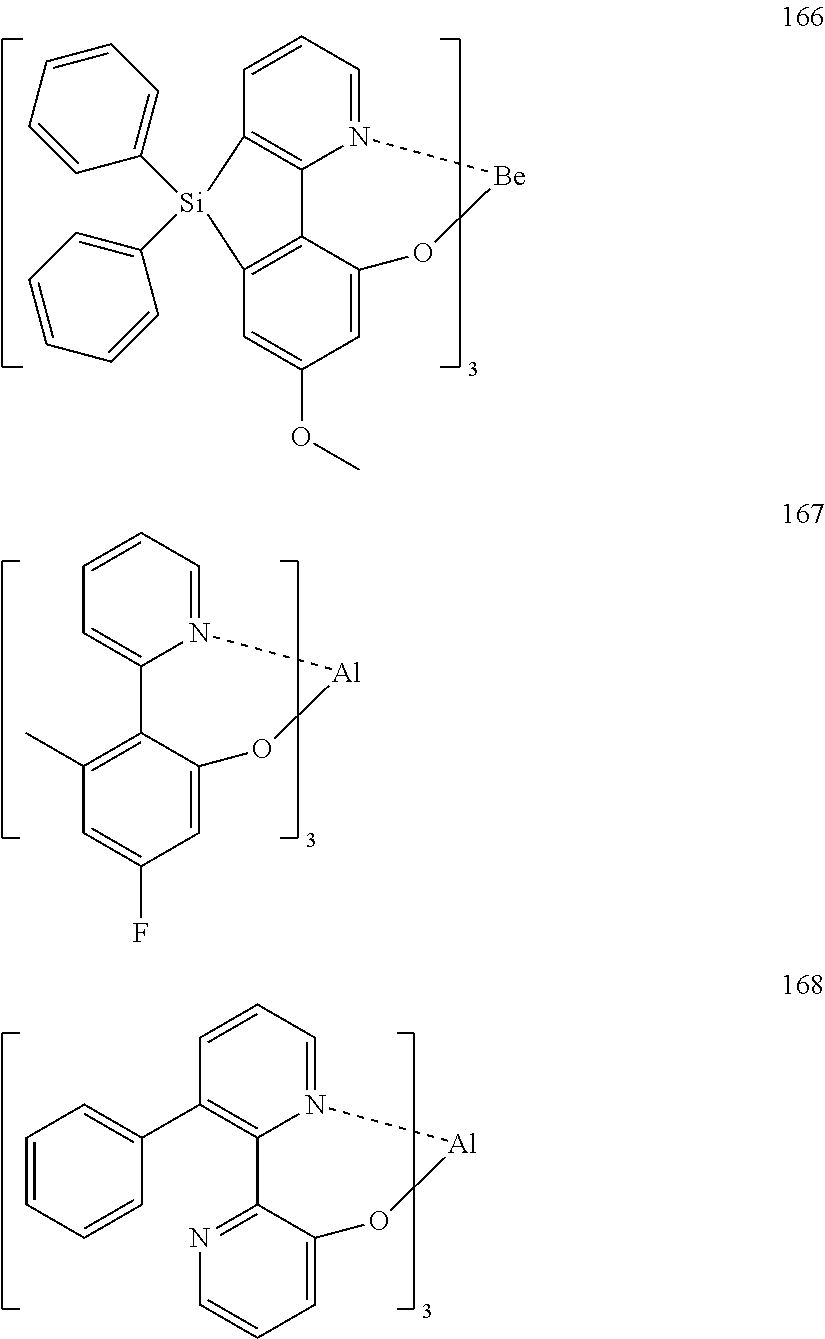
C00040

C00041

C00042
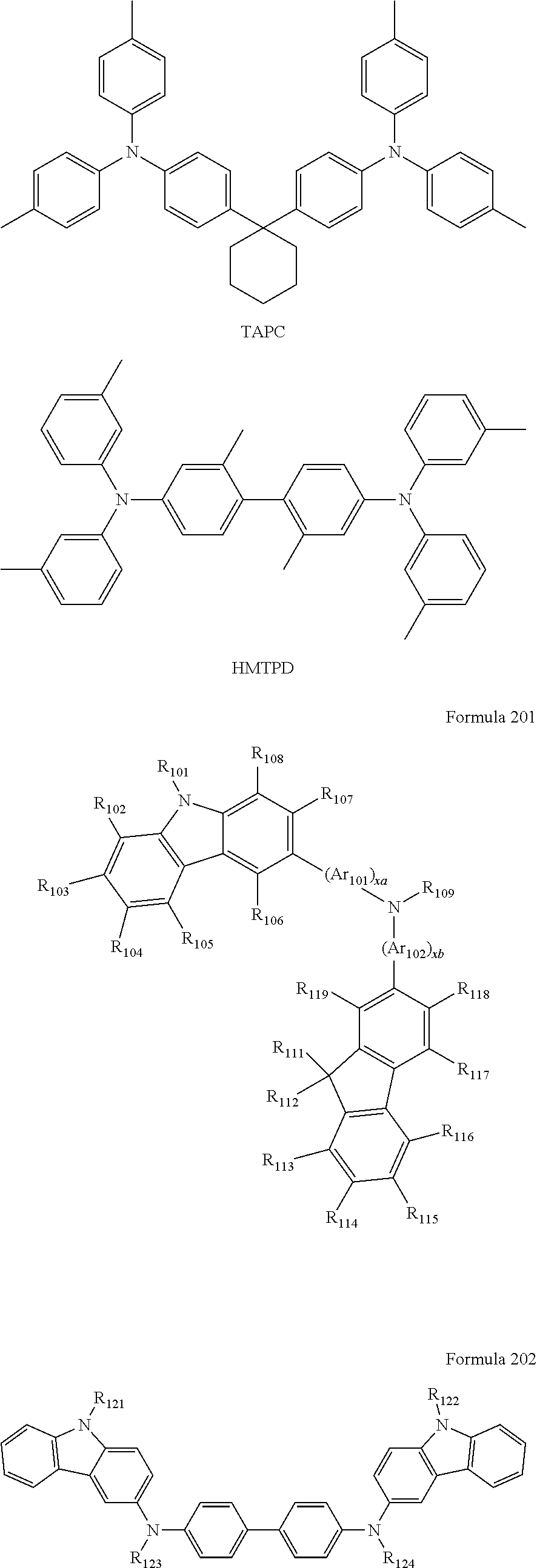
C00043
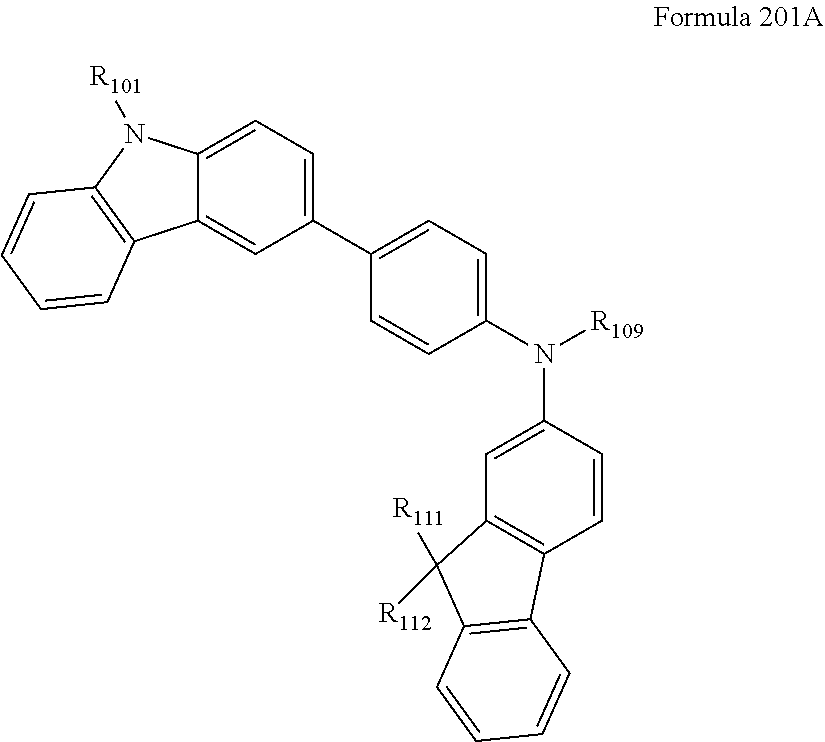
C00044

C00045

C00046

C00047

C00048

C00049

C00050
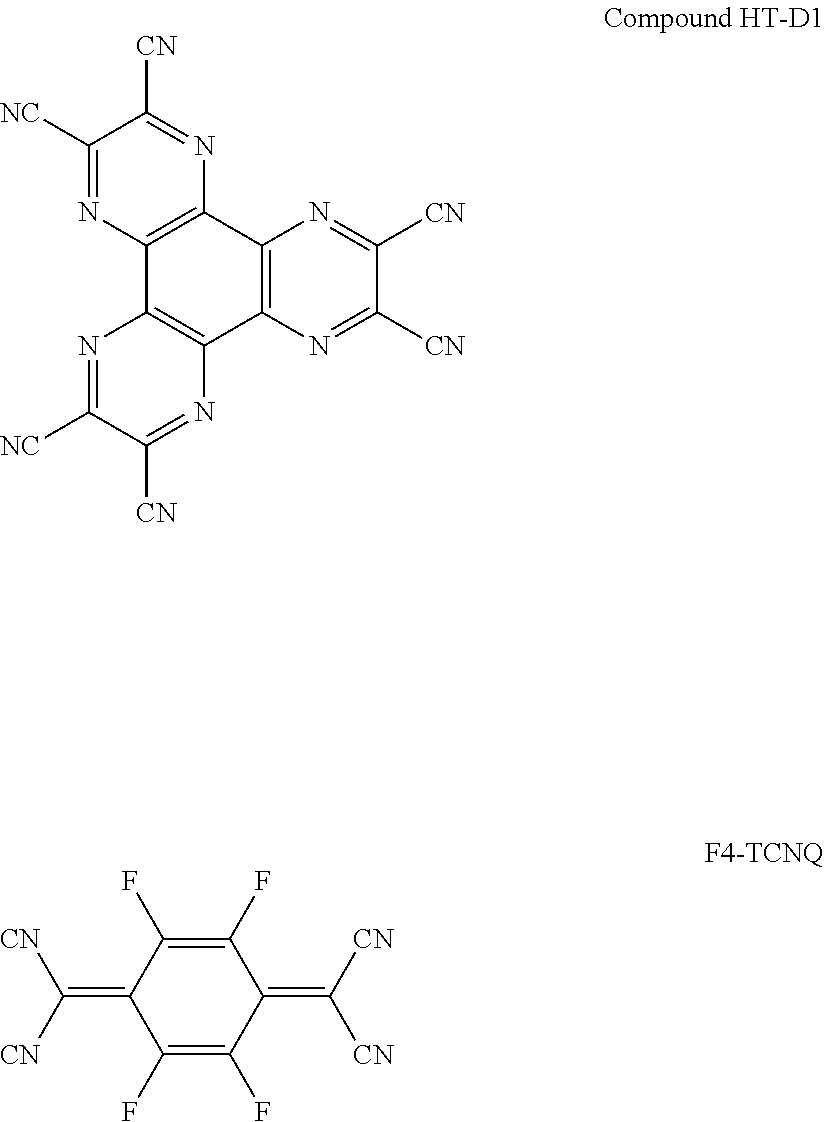
C00051

C00052

C00053

C00054

C00055

C00056

C00057

C00058

C00059
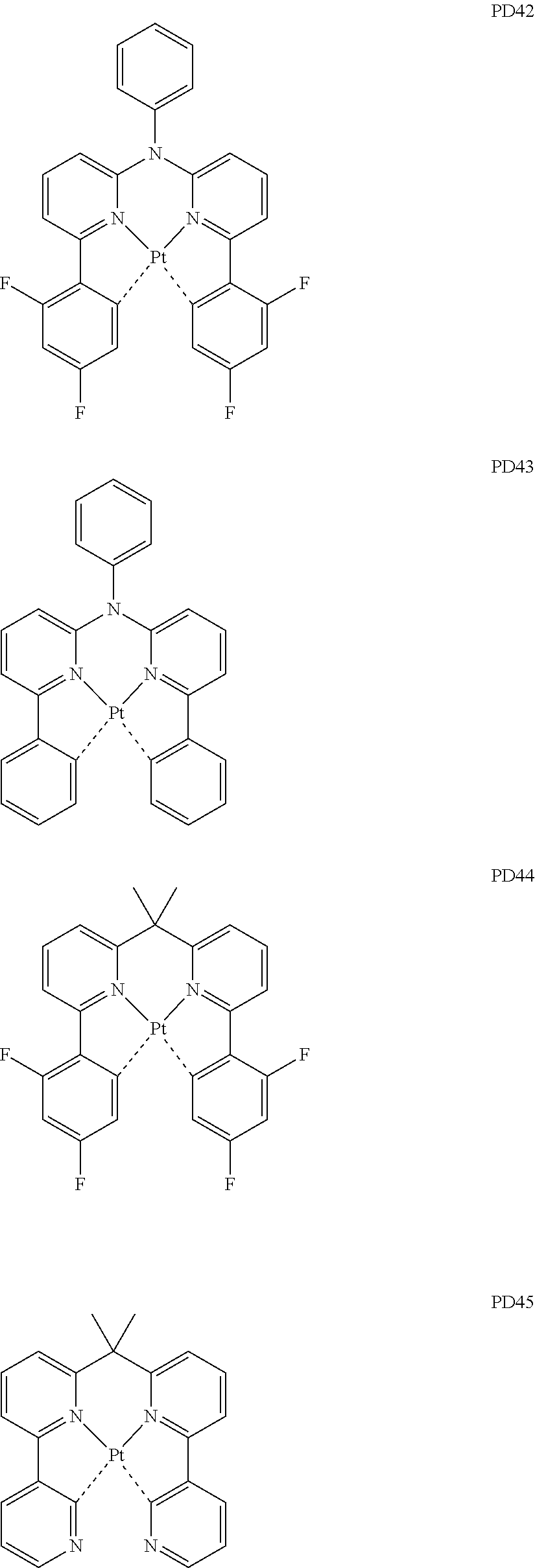
C00060

C00061

C00062

C00063

C00064

C00065
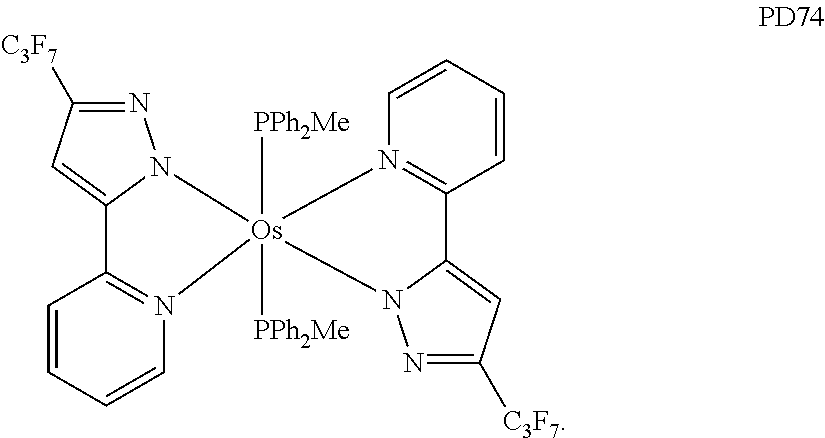
C00066
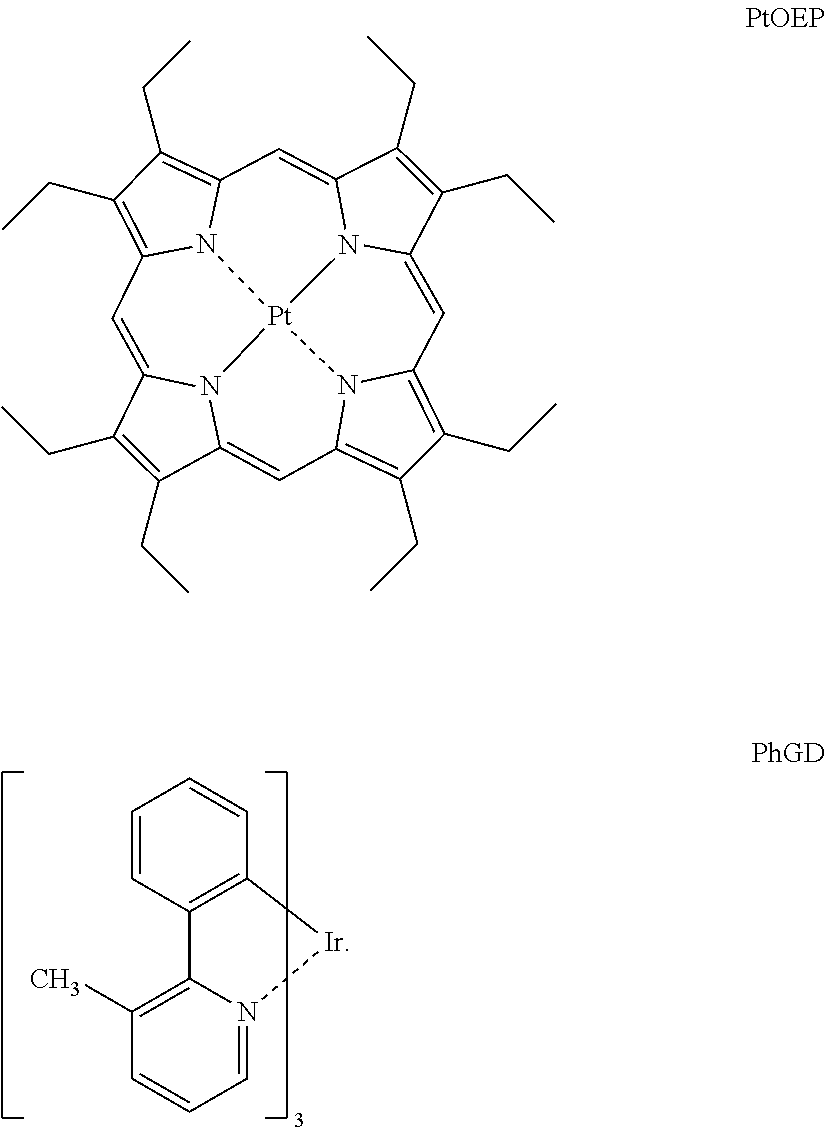
C00067

C00068
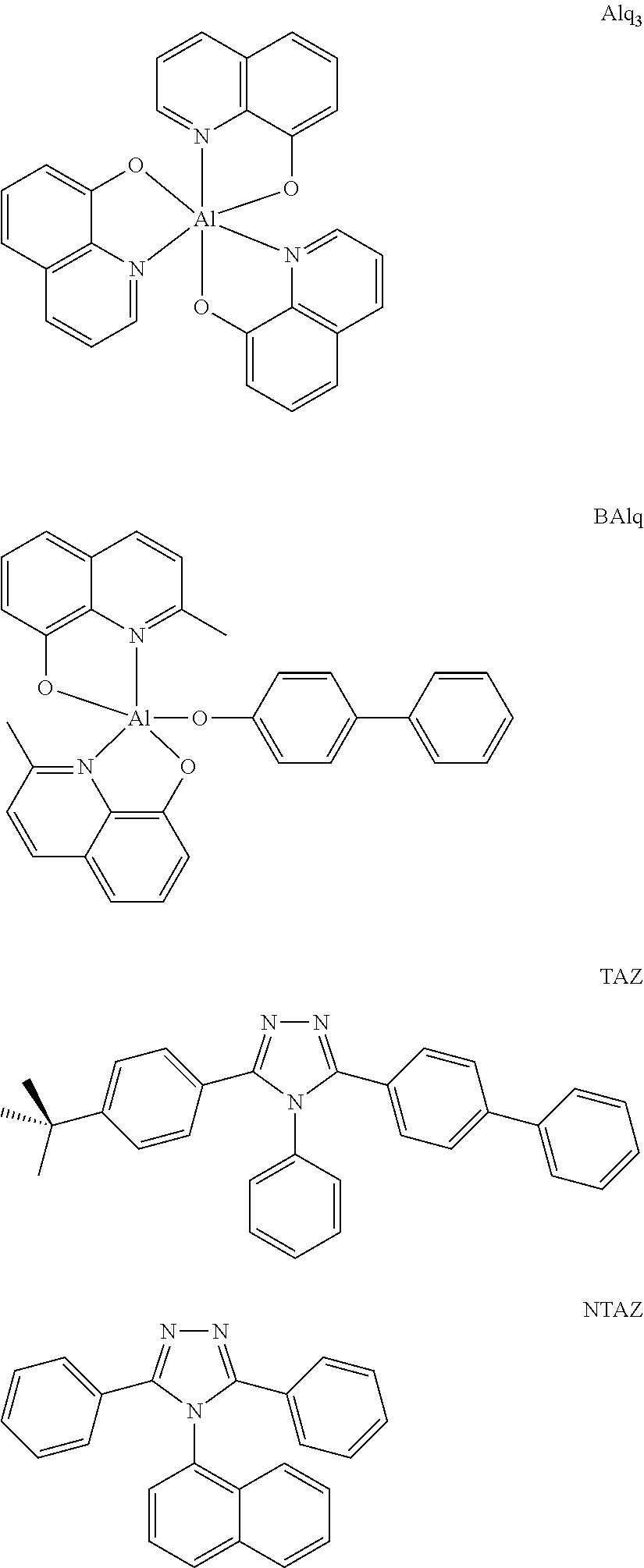
C00069

C00070
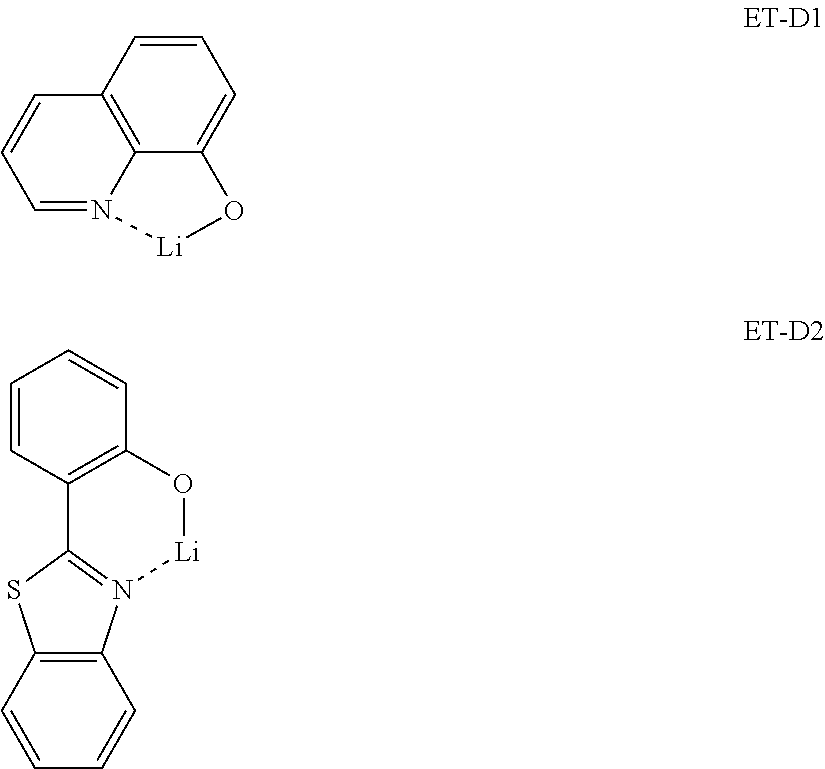
C00071
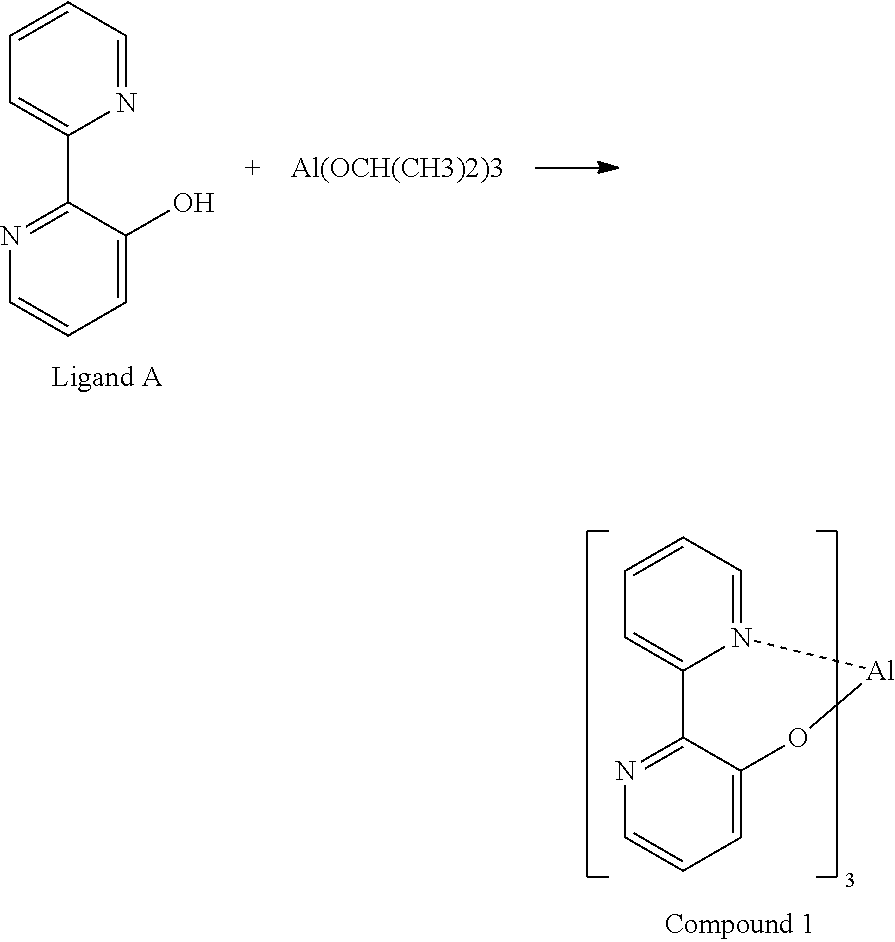
C00072

C00073
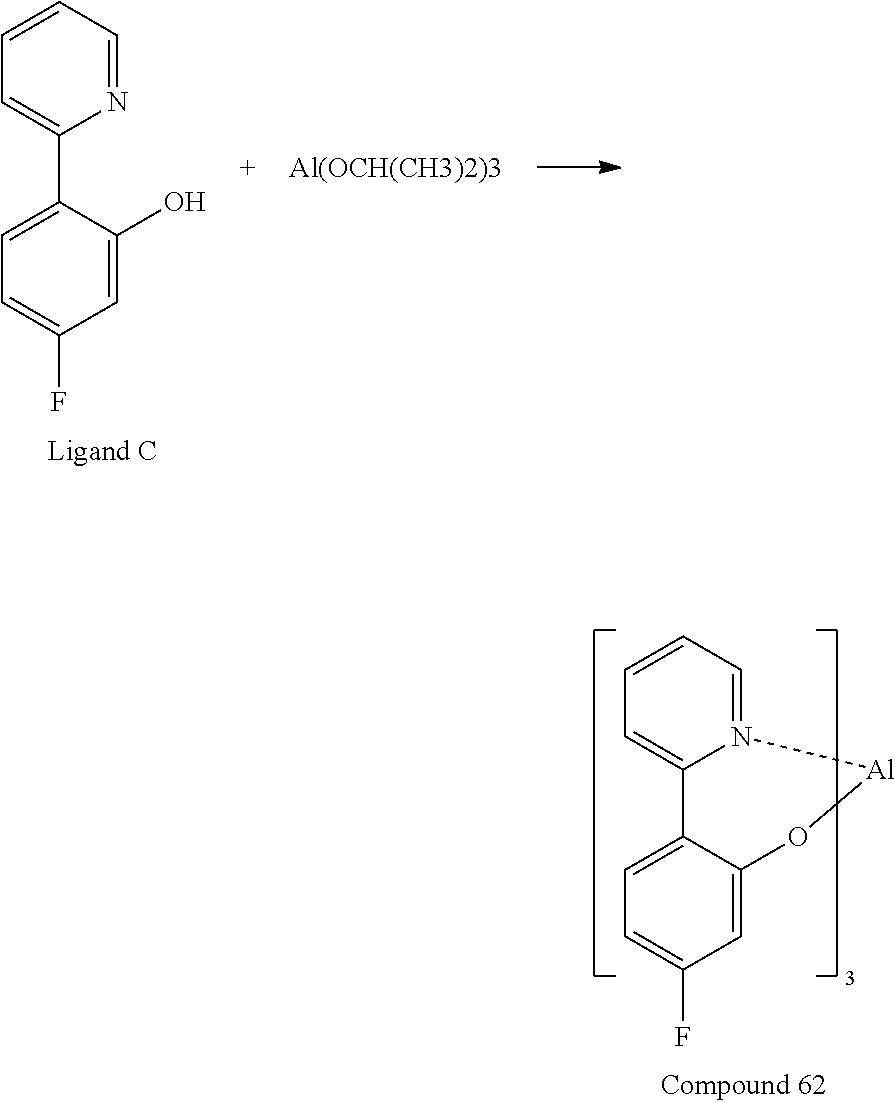
C00074
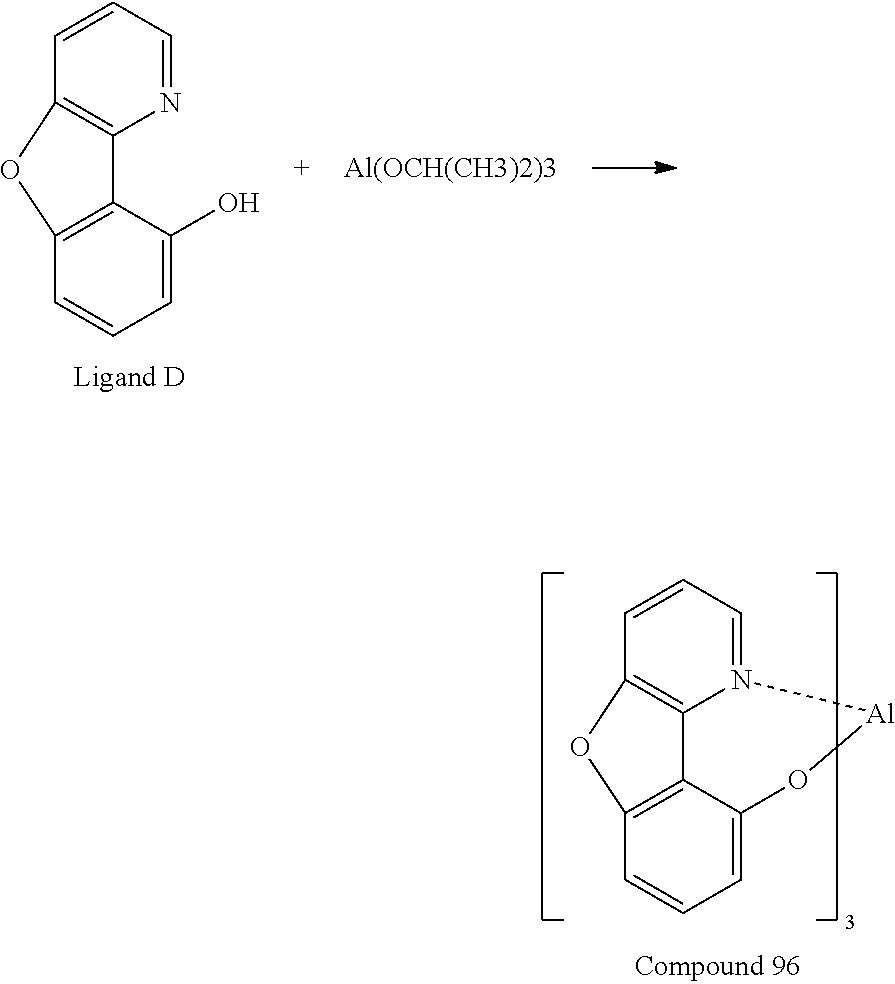
C00075
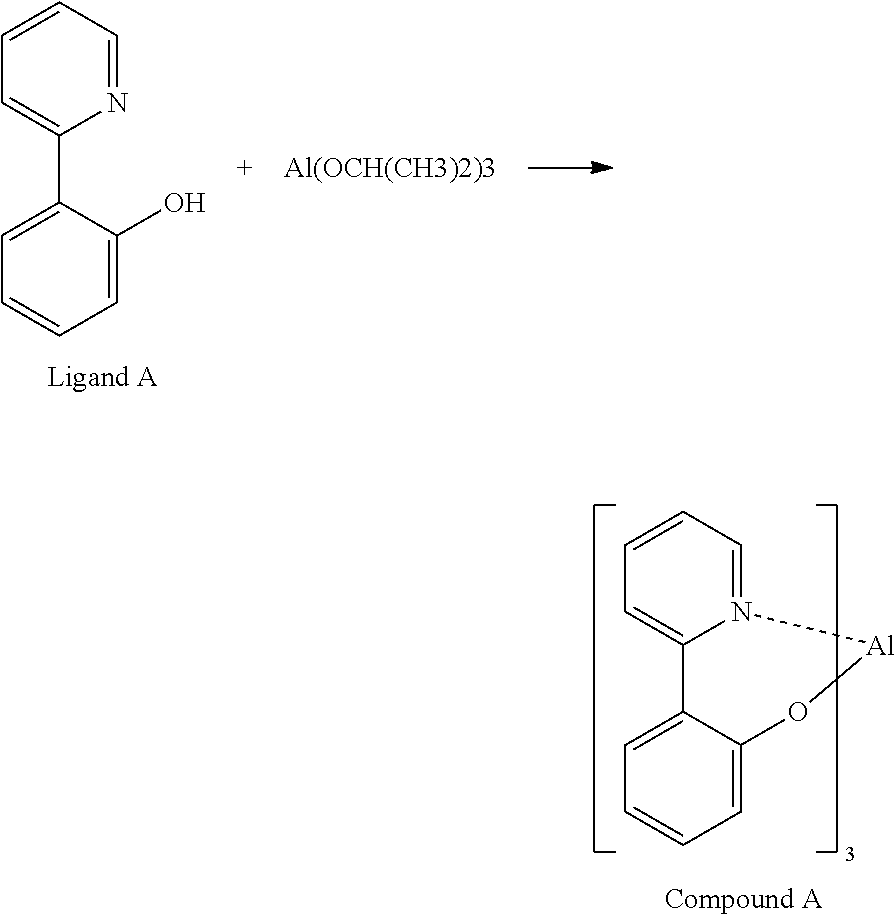
C00076
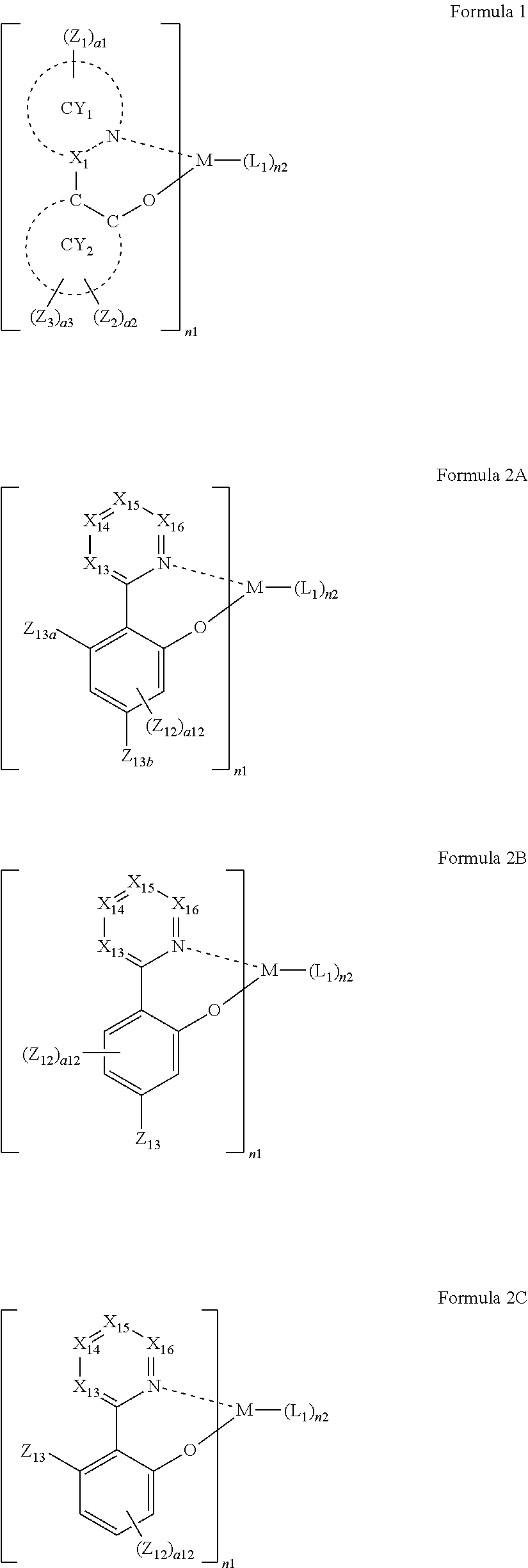
C00077

C00078

C00079
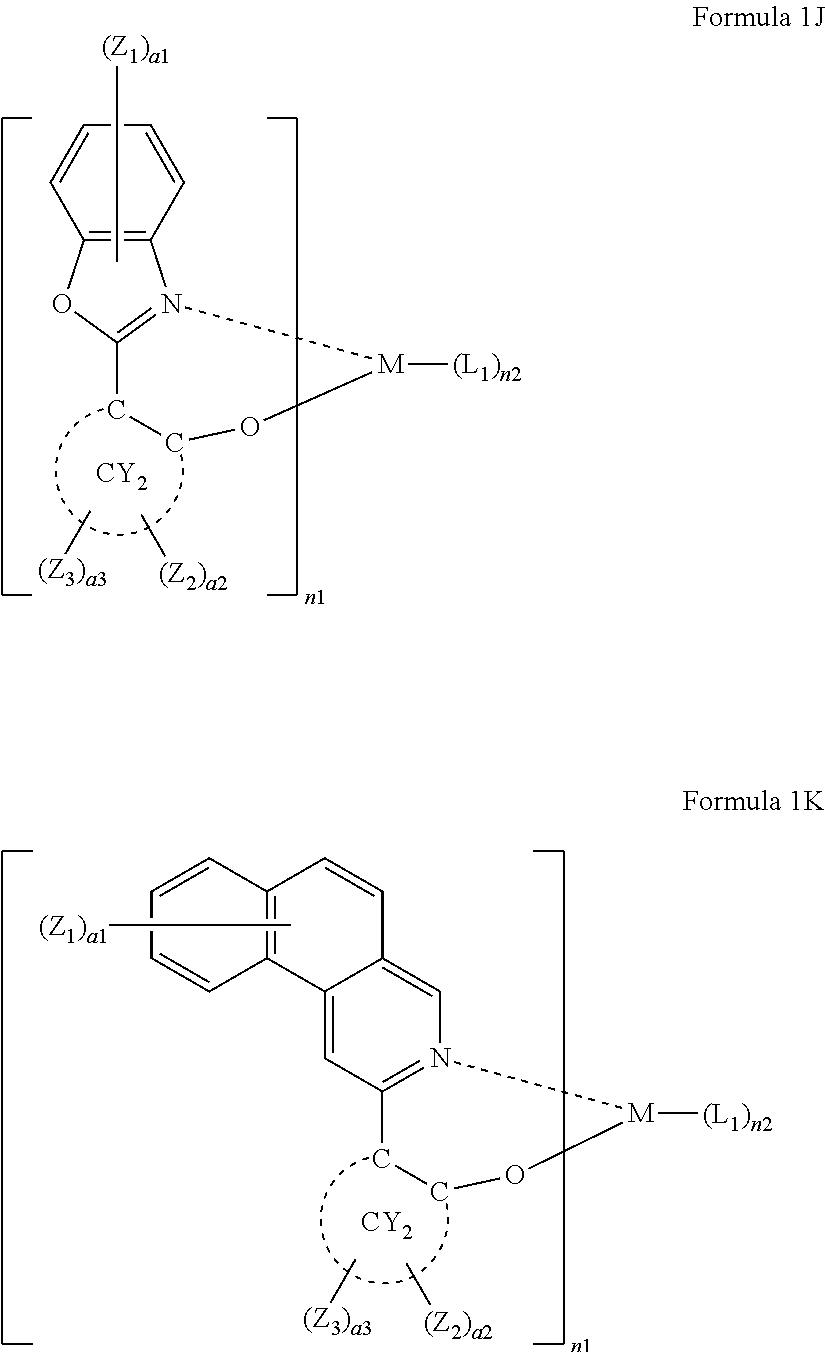
C00080
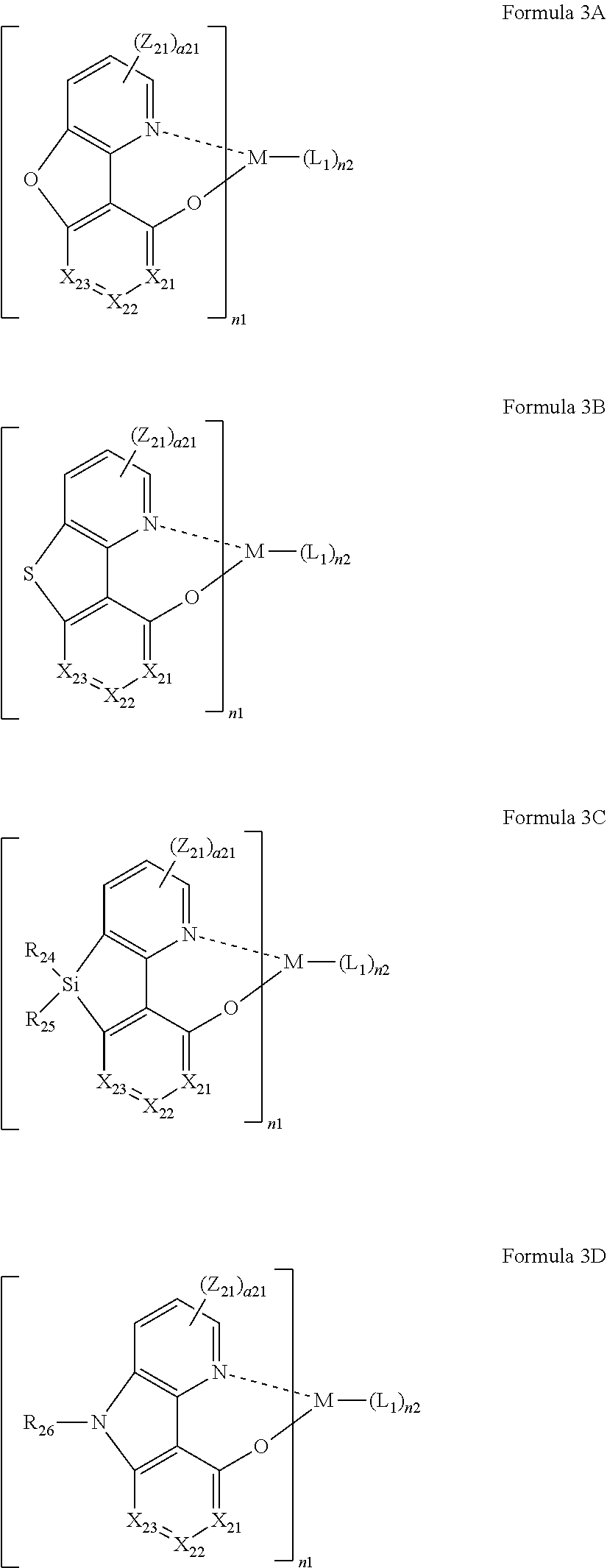
D00000
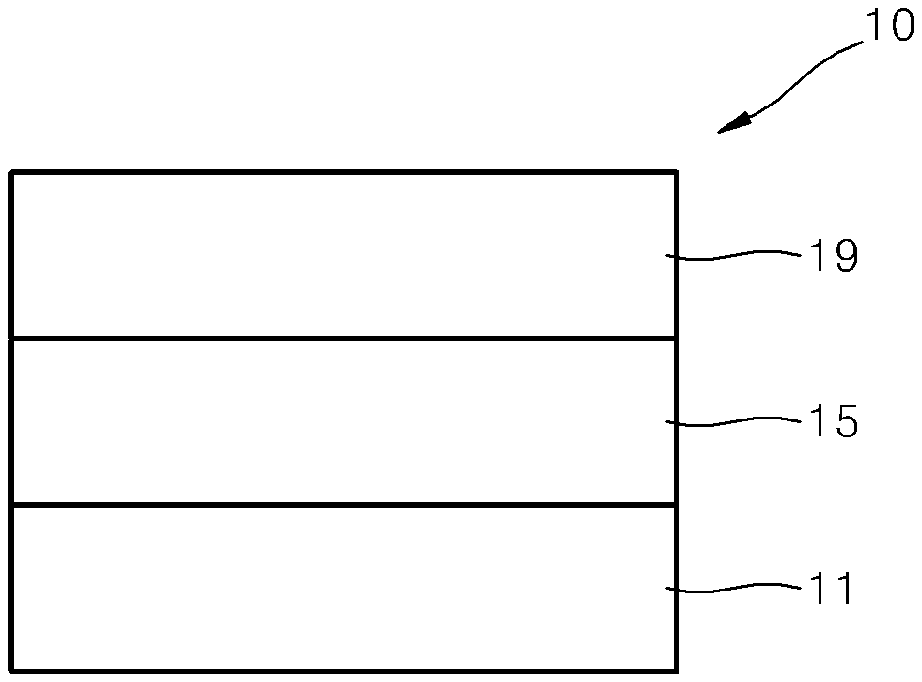
D00001

XML
uspto.report is an independent third-party trademark research tool that is not affiliated, endorsed, or sponsored by the United States Patent and Trademark Office (USPTO) or any other governmental organization. The information provided by uspto.report is based on publicly available data at the time of writing and is intended for informational purposes only.
While we strive to provide accurate and up-to-date information, we do not guarantee the accuracy, completeness, reliability, or suitability of the information displayed on this site. The use of this site is at your own risk. Any reliance you place on such information is therefore strictly at your own risk.
All official trademark data, including owner information, should be verified by visiting the official USPTO website at www.uspto.gov. This site is not intended to replace professional legal advice and should not be used as a substitute for consulting with a legal professional who is knowledgeable about trademark law.